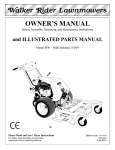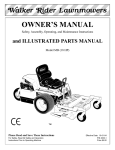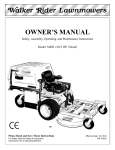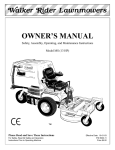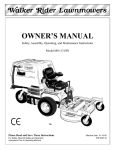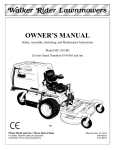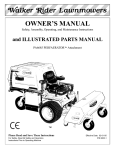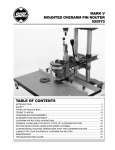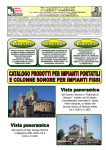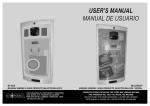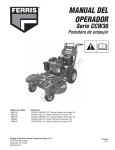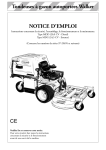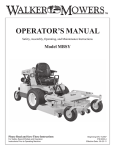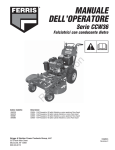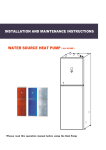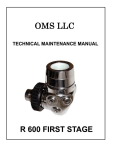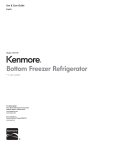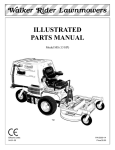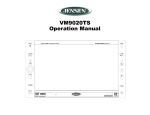Download Walker MW 15 HP User's Manual
Transcript
OWNER’S MANUAL
Safety, Assembly, Operating, and Maintenance Instructions
and ILLUSTRATED PARTS MANUAL
Model MW - Walk-Behind (15 HP)
™
Please Read and Save These Instructions
For Safety, Read All Safety and Operation
Instructions Prior to Operating Machine
Effective Date: 11-01-03
P/N 9001
Price $5.00
Foreword
Thank you. . .for purchasing a Walker by Walker (Model MW). Every effort has been made to provide you with the most reliable product on the market, and we are sure you will be among our many
satisfied customers. If for any reason this product does not perform to your expectations, please
contact an authorized servicing dealer or Walker Manufacturing at (970) 221-5614. Every customer
is important to us. Your satisfaction is our goal.
Please. . .read this manual thoroughly! This manual is to be used in conjunction with the engine
manufacturer’s manual for the specific engine on the mower model you are using. Before you operate your new mower, please read this entire manual. Some of the information is crucial for proper
operation and maintenance of this product - it will help protect your investment and ensure that the
tractor performs to your satisfaction. Some of the information is important to your safety and must
be read and understood to help prevent possible injury to the operator or others. If anything in this
manual is confusing or hard to understand, please call our service department, at (970) 221-5614,
for clarification before operating or servicing this product.
This manual covers the Model MW Walk-Behind (15-HP) mower.
All shields and guards must be in place for the proper and safe operation of this mower.
Where they are shown removed in this manual, it is for illustration purposes only. Do not operate
this product unless all shields and guards are in place.
Specifications given are based on the latest information available at the time this manual was produced.
Walker Mfg. Co. is continually striving to improve the design and performance of its products. We
reserve the right to make changes in specifications and design without thereby incurring any obligation relative to previously manufactured products.
Sincerely,
WALKER MANUFACTURING COMPANY
Bob Walker, President
Table of Contents
Owner’s Manual
Operating Instructions_____________
General Information ________________
1
HIGHLIGHTED INFORMATION _____________ 1
GLOSSARY ____________________________ 1
IDENTIFYING NUMBER LOCATIONS________ 1
ENGINE SERIAL NUMBER LOCATION ______ 2
SERVICING OF DRIVETRAIN GEARBOX ____ 2
Specifications
_______________________ 3
ENGINE________________________________ 3
ELECTRICAL SYSTEM ___________________ 3
TRANSMISSION_________________________ 3
BLADE DRIVE __________________________ 4
TIRE SIZE ______________________________ 4
TIRE PRESSURE ________________________ 4
DIMENSIONS (Tractor and Mower) _________ 4
MOWER DECK __________________________ 5
CURB WEIGHT__________________________ 5
DRIVE BELTS___________________________ 5
FRAME/BODY CONSTRUCTION ___________ 5
Component Identification ___________
6
Safety Instructions __________________
9
BEFORE OPERATING ____________________ 9
OPERATING ___________________________ 10
MAINTENANCE ________________________ 11
SAFETY, CONTROL,
AND INSTRUCTION DECALS _____________ 13
Assembly Instructions
_____________ 14
SETUP INSTRUCTIONS _________________ 14
Tire Installation (Tractor)_______________ 14
Battery Service _______________________ 14
Battery Charging ____________________ 14
Mower Deck Assembly ________________ 15
Deck Caster Wheels Installation ________ 15
Deck Discharge Shield Installation ______ 15
PTO Shaft Guard Installation __________ 16
Tilt-Up Roller Wheel Installation ________ 16
Mower Deck Installation on Tractor ______ 16
Deck Installation ____________________ 16
Deck Leveling ______________________ 18
PREOPERATING CHECKLIST ____________ 19
CONTROL IDENTIFICATION,
LOCATION, AND FUNCTION _____________
Operating Controls ___________________
Engine Throttle/Choke ________________
Forward Speed Control (FSC) __________
Pistol Grips/Steering Control Levers_____
Blade Clutch (PTO) ___________________
Parking Brake _______________________
Engine Cover Latch ___________________
Transaxle Lockout Rods _______________
Hourmeter __________________________
Circuit Breaker _______________________
Ignition Switch _______________________
STARTING THE ENGINE_________________
ADJUSTING GROUND
SPEED AND STEERING _________________
ENGAGING THE MOWER ________________
STOPPING THE MACHINE _______________
ADJUSTING CUTTING HEIGHT ___________
TRANSAXLE LOCKOUTS________________
RECOMMENDATIONS FOR MOWING ______
RECOMMENDATIONS FOR
TILT-UP DECK OPERATION/TRANSPORT __
Maintenance Instructions __________
IMPORTANT TIPS FOR CARE OF THE
KAWASAKI ENGINE ____________________
Fuel System _________________________
Starting/Stopping ____________________
Cooling System ______________________
Air Cleaner System ___________________
Oil _________________________________
MAINTENANCE SCHEDULE CHART _______
LUBRICATION _________________________
Engine Oil___________________________
Engine Break-In Oil __________________
Checking Engine Crankcase Oil Level ___
Changing Engine Crankcase Oil/Oil Filter
Grease Fitting and Oil Point Lubrication__
Mower Deck Gearbox Lubrication _______
DSD52 Mower Deck Lubrication ________
Tractor PTO Gearbox Lubrication _______
Checking Gearbox Oil Level ___________
Transaxle Lubrication _________________
Steering Linkage and
PTO Linkage Lubrication ______________
21
21
21
21
22
22
22
22
22
22
22
22
23
23
23
25
25
26
26
27
28
28
28
28
28
28
28
28
29
30
30
30
30
30
31
31
32
33
33
33
33
Table of Contents
CLEANING ____________________________ 36
Engine Air Cleaner System _____________ 36
Foam Precleaner Element _____________ 36
Paper Precleaner Element ____________ 36
Engine Cooling System ________________ 36
Air Intake Screen ____________________ 36
Engine Cooling Fins _________________ 36
Grass Buildup in Mower Housing________ 36
CHECKING/SERVICING _________________ 37
Battery______________________________ 37
Charging the Battery _________________ 37
Tire Pressure ________________________ 37
Sharpen Mower Blades ________________ 37
Drive Belts __________________________ 38
Mower Deck Gearbox Oil Seals _________ 38
Spark Plugs _________________________ 38
Fuel Lines and Clamps ________________ 38
Blade Brake Action ___________________ 39
REPLACING/REPAIRING ________________ 40
Drive Belts __________________________ 40
PTO Drive Belt _____________________ 40
Ground Drive Belt ___________________ 40
Blade Overload Shear Bolts ____________ 41
PTO Shear Pin _______________________ 41
Mower Blades ________________________ 41
Mower Deck Gearbox Replacement ______ 42
ADJUSTMENTS ________________________ 43
Blade Clutch (PTO) ___________________ 43
Clutch Disengagement/Brake Action _____ 43
Transmission Control _________________ 44
FSC Actuator Stop Adjustment _________ 44
Control Arm Rod Adjustment ___________ 45
Neutral Adjustment __________________ 45
Tracking Adjustment _________________ 45
Control Handle (Pistol Grip) Adjustment __ 46
Handlebar Height Adjustment___________ 46
Tilt-Up Deck Adjustable Stop ___________ 46
Carburetor___________________________ 47
Illustrated Parts Manual
BODY / CHASSIS ASSEMBLY ____________
MAIN COMPONENT
POWER TRANSMISSION ________________
ENGINE GROUP _______________________
FORWARD SPEED &
STEERING CONTROLS__________________
SULKY ATTACHMENT___________________
ELECTRICAL ASSEMBLY ________________
WIRING SCHEMATIC ____________________
48
50
52
54
56
58
60
Maintenance And Service
Record Sheet _______________________
61
Operator’s Notes ___________________
62
Warranty___________________________
63
General Information
HIGHLIGHTED INFORMATION
Walker Manufacturing recommends that any service
requiring special training or tools be performed by
an authorized Walker Mower Dealer. There are several general practices to be aware of in the area of
safety. Most accidents associated with the operation or maintenance of a Walker product are
caused by disregarding basic safety precautions or
specific warnings. Such accidents, in most cases,
can be prevented by being aware of the dangers
present.
Information of special importance has been highlighted in bold type in this manual. Refer to Safety
Instructions for the meanings of DANGER, WARNING, CAUTION, IMPORTANT, and NOTE.
•
SIDE DISCHARGE (SD) mows but does not
collect the mowed material.
•
TRACTOR is the prime mover, including the engine, drive train, and controls to operate the
mower.
IDENTIFYING NUMBER LOCATIONS
The mower serial number is affixed to RH side of the
inside of the unit housing. Model and serial numbers
are helpful when obtaining replacement parts and
maintenance assistance. For ready reference,
please record these numbers in the space provided.
Tractor Model No. _______________________
GLOSSARY
Tractor Serial No. _______________________
There are many terms that are either unique to this
equipment or that are used as acronyms. The following terms and their definitions will help while using this manual:
Deck Serial No.
•
Engine Serial No. _______________________
DECK is the mowing attachment mounted on
the front of the tractor which includes the carrier
frame, deck housing, blade drive gearboxes,
and cutter blades.
•
FORWARD
SPEED
CONTROL
(FSC)
SWITCH controls the maximum forward speed
of the tractor; functioning as a cruise control.
•
GROUND DRIVE refers to the dual hydrostatic
transmissions which drive the main wheels.
•
LEFT HAND (LH) refers to the left-hand side of
the tractor when the operator is seated facing
forward from the operator position.
•
NEUTRAL LOCKOUT releases the hydrostatic
transaxles to permit freewheeling the tractor.
•
PISTOL GRIPS steer the tractor by controlling
the dual hydrostatic transaxles.
•
POWER TAKE-OFF (PTO) transmits engine
power to run the cutter blades.
•
RIGHT HAND (RH) refers to the right-hand side
of the tractor when the operator is facing forward from the operator position.
_______________________
Engine Model No. _______________________
Date of Purchase _______________________
Fill In By Purchaser
Ref. RH
Drive Wheel
Ref. Engine
Air Cleaner
Serial
Number Plate
Tractor Serial Number Location
(Top View of Tractor)
1
General Information
SERVICING OF DRIVETRAIN GEARBOX
Serial Number
Deck Serial Number Location
ENGINE SERIAL NUMBER LOCATION
The Kawasaki engine model, type, and code numbers are located on the side of the engine opposite
the recoil starter handle (on the aluminum housing).
For the mower model covered by this manual, an engine manual is available to cover the Kawasaki
FH430V.
Serial Number
Engine Serial Number Location
2
The detailed servicing and repair of the engine, hydrostatic transmission, and gearboxes are not covered in this manual. Only routine maintenance and
general service instructions are provided. For the
service of these components during the limited warranty period, it is important to find a local, authorized
servicing agent of the component manufacturer.
Any unauthorized work done on these components during the warranty period may void the warranty.
If you have any difficulty finding an
authorized outlet or obtaining warranty service,
please contact our Service Department for assistance:
Walker Manufacturing Company
5925 E. Harmony Road
Fort Collins, CO 80528
1-970-221-5614
Service manuals are available for each of these
components from their respective manufacturers as
follows:
Kawasaki Engines Kawasaki Tractor Corp.
P.O. Box 888285
Grand Rapids, MI 49588-8285
Transmissions
HydroGear Corporation
Sullivan, IL
Gearboxes
(Deck & PTO)
Tecumseh Products Co.
900 North Street
Grafton, Wl 53024
Specifications
MODEL
MW
ENGINE
Manufacturer/Model
Kawasaki, FH430V, OHV, 2 Cyl. V-Twin (Air-Cooled)
Displacement
431CC (26.3 cu. in.)
HP (@ 3600 RPM)
15
Max. RPM (No Load)
4000
Governed RPM
3600
Max. Torque [ft-lb (N⋅ m) @ RPM]
23.6 (32 N•m) @ 2400
Idle RPM
1500
Spark Plug Type
Champion® RCJ8Y
Spark Plug Gap
.030 in. (.75 mm)
Crankcase Capacity
1.8 qts (1.7 liters)
Crankcase Lubricant
API SC/SD/SE/SF/SG/SH Grade Oil Only with 10W-30/10W-40
Viscosity or 40W Above 68° F (20° C) Only
Fuel Tank Capacity
3 Gallons (11.4 liters)
Fuel
Automotive Grade Unleaded Gasoline (87 Octane)
ELECTRICAL SYSTEM
Battery
12-Volt, Interstate PC1250
Charging System
12.5 Amp Alternator
Charging Output
15 Amp DC (Regulated)
System Polarity
Negative Ground
Ignition
Electronic Magneto
Starter
Recoil Starter
Interlock Switch
Ignition Lockout by Operator Presence Lever, Transmission Neutral
and Blade Clutch
TRANSMISSION
Manufacturer/Model
Dual, Independent Hydro-Gear Integrated Transaxles
Steering
Handle Pistol Grips
Forward Speed Control
Variable Speed Controlled by Rocker Switch Near RH Thumb, with
Neutral Park Setting
Service Brake
Mechanical Lockout for each Transmission (Single Lever Control)
Neutral
Transmission Release by Manual Dump Valve
3
Specifications
MODEL
MW
TRANSMISSION (continued)
Transmission Fluid
Factory Service
20W50 Multi-Viscosity Motor Oil
Transmission Fluid Capacity
79 fl. oz. (2336 ml.)
Transmission Cooling
Cooling Fan Mounted on Drive Pulley
Ground Travel Speed
Forward m.p.h. (km/h)
Reverse m.p.h. (km/h)
0-5 (0-8) Infinitely Variable
0-2 (0-3) Infinitely Variable
BLADE DRIVE
PTO Shaft
Quick Disconnect Splined Shaft with Two (2) High-Speed U-Joints
Blade Spindle
Each Blade (2) Mounts Direct on Peerless Right Angle
Gearbox with Tee Gearbox in Center Connected to PTO Shaft
(Complete Geared Drive, Peerless Model 1000 Gearboxes)
Blade Drive Clutch and Brake
Manual Belt Tightener Clutch and Band Brake
(Stops Blades within Five (5) Seconds of Disengagement)
Max. Blade Speed
[25 in. (64 cm) Blade] @ 3600
RPM Engine
2400 RPM
[15700 FPM (4785 m/min)]
(48" Deck)
TIRE SIZE
Deck Caster Wheel
2.80/2.50-4 Pneumatic (4-Ply)
Deck Caster Wheel (Optional)
8.25 x 2.75 Foamed Rubber
Drive
18 x 8.50-10 (Low-Profile)
Rear
2.80/2.50-4 Pneumatic (4-Ply)
Rear Wheel (Optional)
8.25 x 2.75 Foamed Rubber
TIRE PRESSURE
Deck Caster Wheel
20 PSI (137 kPa)
Drive
15 PSI (103 kPa)
Rear
20 PSI (137 kPa)
DIMENSIONS (Tractor and Mower)
4
Length
80 in. (203 cm)
Width
48-3/4 in. (124 cm)
Height
44-3/4 in. (114 cm)
Wheel Base (Tractor)
22 in. (56 cm)
Tread Width (Tractor)
29-1/4 in. (74 cm)
Specifications
MODEL
MW
MOWER DECK
Width of Cut
36-, 42-, 48-, 52-, or 56-in.(91, 107, 122, 132, or 142 cm)
Cutting Height
1 to 4 in. (3 to 10 cm)
Height Adjustment
7 Positions - 1/2 in. (1 cm) Increment Hitch Pins Installed in
Multi-Position Deck Support
Blade Size
42 in. (107 cm)
22 in. (56 cm) 2 in. (5 cm) Center Overlap
(Two Blades, CW Rotation)
48 in. (122 cm)
48 in. (122 cm) 25 in. (64 cm) 2 in. (5 cm) Center Overlap
(Two Blades, CW Rotation)
Deck Suspension
Torsion-Flex Frame with Caster Wheels and
Counterweight Springs
CURB WEIGHT (Approximate)
Tractor Only
370 lb (168 kg)
Tractor and Deck
520 lb (236 kg)
* Dimensions and weight shown are for 48 in. (122 cm) SD Deck (Typical)
DRIVE BELTS
Engine PTO
Walker P/N 9230
Ground Drive
FRAME/BODY CONSTRUCTION
Walker P/N 9248
Frame/Body
3/16 Plate Steel
Deck
11 Gauge Steel
NOTE: The manufacturer reserves the right to make changes in specifications shown herein at any time
without notice or obligation.
5
Component Identification
NOTE: Control Identification
shown in Operating
Instructions section.
Throttle/Choke
Control & Cable
Engine
Cover Latch
Engine
Cover
Tilt-Up
Latch
Spring Clip
Fuel Tank
and Cap
Counterweight Spring
and Protective Cover
Deck Support Pins
and Height Adjustment
Hitch Pins
Parking
Brake Handle
Footrests
Fuel Filter
Tilt-Up
Handle
Tail Wheel
Deck
Caster Wheels
Right Hand
Drive Wheel
Deck Support
Arms
Tilt-Up
Hook
Deck Lift Handle
(Cutting Height Adjustment)
Front View and Right Side View
6
Discharge Shield
Component Identification
Operator Presence Switch Control
PTO Clutch
Lever
Tailpipe
Pistol
Grips
Muffler
Steering Control
Rod (RH)
Steering Control
Rod (LH)
Left Hand
Drive Wheel
Transaxle (LH)
Transmission
Neutral Lockout
Rods
Rear View and Left Side View
7
Component Identification
Fuel Pickup
Line
FSC
Electric
Actuator
Oil Dipstick/
Oil Fill
Recoil
Starter Handle
Oil Filter
Fuel
Pump
Parking
Brake
Linkage
Transaxle
Pressure
Relief
Valve [(LH)
Not Visible]
Transaxle
Pressure
Relief
Valve (RH)
Counterweight
Dampening Spring
Battery
Counterweight
Dampening Spring
Top View (Cover Removed)
8
Safety Instructions
Pay particular attention to any information labeled
DANGER, WARNING, CAUTION, IMPORTANT,
and NOTE in this manual.
When you see the Safety Alert Symbol (
),
read, understand, and follow the instructions. Failure to comply with safety instructions may result in
personal injury.
The seriousness or degree of importance of each
type of information is defined as follows:
DANGER
An IMMEDIATE hazard that WILL result in
severe personal injury or DEATH, if warning is ignored and proper safety precautions are not taken.
Walker Manufacturing cannot predict every potentially dangerous situation. Therefore, items labeled
as such in this manual do not cover all conceivable
situations. Any person using procedures, tools, or
control techniques not recommended by Walker
Manufacturing must take full responsibility for safety.
The mower has been designed with many safety
features to protect the operator from personal harm
or injury. However, it is necessary for the operator
to use safe operating procedures at all times. Failure to follow safety instructions contained in
this manual may result in personal injury or
damage to equipment or property.
If you have any questions concerning setup, operation, maintenance, or safety, please contact your
authorized Walker Mower Dealer or call Walker
Manufacturing Company at (970) 221-5614.
BEFORE OPERATING
WARNING
1.
A POTENTIAL hazard that COULD result in
severe personal injury or DEATH, if warning is ignored and proper safety precautions are not taken.
Walker Manufacturing Company
5925 East Harmony Road
Fort Collins, CO 80528
CAUTION
Possible hazards or unsafe practices that
MAY result in MODERATE personal injury
or property damage, or machine damage, if
warning is ignored and proper safety precautions are not taken.
IMPORTANT: Identifies mechanical information
demanding special attention, since it deals with the
possibility of damaging a part or parts of the machine.
Read and understand the contents of this
Owner’s Manual before starting and operating the machine. Become thoroughly familiar
with all machine controls and how to stop the
machine and disengage the controls quickly.
Replacement Owner’s Manuals are available
by sending the Model and Serial Number to:
2.
Never allow children to operate the machine. Do not allow adults to operate without
proper instruction.
3.
The mower should be operated by one (1) person
at a time (do not give rides on the engine cover).
4.
Keep everyone, especially children and pets, a
safe distance away from the area being mowed.
Do not operate with bystanders in the area.
5.
Do not operate the machine wearing sneakers,
tennis shoes, or similar lightweight footwear.
Wear substantial protective footwear that
will improve footing on slippery surfaces.
6.
Ground cover or leaves can sometimes hide objects that might cause damage to the mower or
make unstable footing for the operator. Clear
the area of objects and mark all sprinkler heads
and/or utility box covers.
NOTE: Identifies information worthy of special
attention.
9
Safety Instructions
7.
8.
9.
Do not wear loose fitting clothing that could get
caught in moving parts. Always wear adequate protective clothing including long
pants. Wearing safety glasses and safety
shoes is advisable and required by some local
ordinances and insurance regulations.
13. The electrical system battery contains sulfuric
acid. Avoid any contact with skin, eyes, and
clothing. Keep the battery and acid out of reach
of children.
Prolonged exposure to loud noise can cause
impairment or loss of hearing. Operator hearing protection is recommended. Wear a suitable hearing protective device, such as
earmuffs or earplugs.
1.
Operate the mower only in daylight or in
good artificial light with good visibility of the area
being mowed.
2.
Keep feet behind the tractor at all times and always maintain secure footing when the tractor
is moving and/or mower blades are operating.
3.
Use extreme caution when reversing the machine towards you.
4.
For a beginning operator, learn to steer (maneuver) the tractor with a slow engine speed
before attempting any mowing operation.
Be aware that, with the front mounted mower
configuration, the back of the tractor can raise
off the ground slightly when going into reverse
at high speeds.
5.
Remember, for an emergency stop, the forward
motion of the tractor can always be stopped by
allowing the operator presence control (on top
of handle bars) to raise up.
6.
Disengage the blade clutch and put the FSC in
the NEUTRAL-PARK position before starting
the engine (an ignition interlock switch normally
prevents starting of the machine if these controls are in the OPERATING position).
7.
Do not run the engine in a confined area
without adequate ventilation. Exhaust fumes
are hazardous and can be deadly.
8.
Watch for holes, rocks, and roots in the terrain
and for other hidden hazards. When mowing
tall grass, mow higher than desired to expose
any hidden obstacles. Then, clean the area and
mow to the desired height.
9.
Avoid sudden starts or stops. Before backing
the machine up, look to the rear to be sure the
area behind you is clear of obstacles. Watch
carefully for traffic when crossing or working
near roadways.
Keep all protective shields and safety devices in place. If a protective shield, safety
device, or decal is damaged, unusable, or missing, repair or replace it before operating the machine.
10. Be sure interlock switches are functioning
correctly so the engine cannot be started unless the Forward Speed Control switch is in the
NEUTRAL-PARK position and the PTO clutch
is in the DISENGAGED position. Also, the engine should stop if the operator lifts their hands
off the operator presence control with the PTO
clutch in the ENGAGED position and/or moving
forward (FSC switch out of neutral).
11. Never attempt to make any adjustments
while the engine is running, except where
specifically instructed to do so.
OPERATING
12. Handle gasoline with care. Gasoline is highly
flammable and its vapors are explosive:
a.
Use an approved fuel container.
b.
Never add fuel to a running engine or hot
engine (allow hot engine to cool several
minutes).
c.
Keep matches, cigarettes, cigars, pipes,
open flames, or sparks away from the fuel
tank and fuel container.
d.
Always fill the fuel tank outdoors using
care. Fill to about one inch from the top of
the tank. Use a funnel or spout to prevent
spilling.
e.
10
Replace the machine fuel cap and container
cap securely and clean up any spilled fuel
before starting the engine.
Safety Instructions
10. Disengage the blade drive when transporting
the machine across drives, sidewalks, etc.
Never raise the mower deck while blades are
rotating.
11. The maximum recommended side slope operating angle is 20 degrees or 33% grade.
When operating the machine on a slope, reduce
ground speed and use caution to start, stop,
and maneuver. To prevent tipping or loss of
control of the machine, avoid sharp turns or
sudden changes in direction.
12. Never adjust cutting height with the engine
running. Before adjusting cutting height or
servicing, disengage the blade clutch (PTO),
stop the engine, and remove the ignition key.
Wait for all movement to stop before leaving the
operator position.
NOTE: A blade brake should normally stop
drive line rotation within five (5) seconds of disengaging the PTO clutch.
13. For side discharge mower decks, do not operate with the grass deflector chute removed.
Keep the deflector in the lowest possible position.
14. For tractors equipped with tilt-up deck, do not
move tractor with deck in tilt-up position.
the mower and repair any damage before restarting the engine and operating the mower.
Make sure cutter blades are in good condition
and blade nuts are torqued to 60 ft-lb (81.3
N⋅ m).
17. Do not touch the engine, engine cover, or
muffler while the engine is running or immediately after stopping the engine. These areas
may be hot enough to cause serious burns.
18. When leaving the machine unattended, disengage the blade clutch (PTO), stop the engine, and remove the key.
MAINTENANCE
1.
To prevent accidental starting of the engine
when servicing or adjusting the machine, remove the key from the ignition switch and disconnect the spark plug wires.
2.
To reduce fire hazards, keep the engine free of
grass, leaves, excessive grease, and dirt.
3.
Keep all nuts, bolts, and screws tight to ensure
the machine is in a safe, working condition.
Check the blade mounting nuts frequently, making sure they are tight.
4.
Perform only maintenance instructions described in this manual. Unauthorized maintenance operations or machine modifications
may result in unsafe operating conditions.
5.
If the engine must be running to perform a maintenance adjustment, keep hands, feet, and
clothing away from moving parts. Do not wear
jewelry or loose clothing.
6.
Always use the proper engine service manual when working on the engine. Unauthorized maintenance operations or modifications
to the engine may result in unsafe operating
conditions.
7.
Altering the equipment or engine in any manner
which adversely affects its operation, performance, durability, or use will VOID the warranty and may cause hazardous conditions.
8.
Never attempt to disconnect any safety devices
or defeat the purpose of these safety devices.
15. In case of a clogged or plugged mower
deck:
a.
Disengage the blade clutch (PTO) and
turn the engine off before leaving the
operator position (behind the handles).
b.
LOOK to make sure blade drive shaft
movement has stopped before trying to
unclog the deck.
c.
Disconnect the spark plug wires.
d.
Never place hands under the deck - use a
stick or similar tool to remove clogged
material.
16. If the cutting blades strike a solid object or the
machine begins to vibrate abnormally, immediately disengage the blade clutch (PTO), stop
the engine, and wait for all moving parts to
stop. To prevent accidental starting, disconnect the spark plug wires. Thoroughly inspect
11
Safety Instructions
9.
Do not change the engine governor settings or
overspeed the engine. The governor has been
factory-set for maximum-safe engine operating
speed.
10. Use genuine factory replacement parts.
Substitute parts may result in product malfunction and possible injury to the operator and/or
others.
11. Use care when charging the battery or performing maintenance on the battery and electrical system:
a.
Make sure the battery charger is unplugged
before connecting or disconnecting cables
to the battery.
b.
Charge the battery in a well-ventilated
space, so gases produced while charging
can dissipate.
c.
Keep sparks, flames, and smoking materials away from the battery at all times. To
avoid sparks, use care when removing battery cables from posts.
d.
Disconnect both battery cables before
unplugging any wiring connectors or making repairs on the electrical system.
IMPORTANT: Keep all applicable manuals
immediately accessible to anyone who may
operate or service this machine.
12
Safety Instructions
SAFETY, CONTROL, AND INSTRUCTION DECALS
Safety, Control, and Instruction Decals are installed on the machine; if any are missing, illegible, or
damaged, a replacement should be ordered and installed before putting the machine into operation. The
Decal Part Number is listed below and in the Parts List.
Control Panel (Walker P/N 9801)
On Body Adjacent
to Parking Brake Lever
(P/N 9802)
On Body Adjacent
to Clutch Control Lever
(P/N 9803)
On Rear of Body Above
Neutral Lockout Arms (2)
(P/N 9804)
13
Assembly Instructions
SETUP INSTRUCTIONS
Battery Charging
Walker Mowers are shipped partially assembled.
After uncrating the tractor and mower deck, initial
setup is required.
NOTE: During the process of unpacking, any damaged or missing parts should be noted and reported
to the delivering carrier immediately (put in writing
within 15 days). The carrier will provide directions
for proceeding with a claim to receive compensation
for damage.
DANGER
BATTERIES PRODUCE EXPLOSIVE GASES
• Charge the battery in a well-ventilated
area, so that gases produced while charging can dissipate.
• Keep sparks, flames, and smoking materials away from the battery at all times.
Tire Installation (Tractor)
• Install the drive tires using the eight (8) lug bolts
that are supplied with the owner’s packet of materials. Drive tires are 18 x 8.50-10, 4-ply; rear tire is
2.80/2.50-4 Pneumatic (4-Ply).
• Check and adjust the inflation of the tires. The
tire inflation recommendations are:
Drive = 15 PSI (103 kPa)
Rear = 20 PSI (137 kPa)
Battery Service
The battery is a completely sealed, non-serviceable
battery.
IMPORTANT: Make sure battery is securely
mounted in the frame. A loose battery may cause
damage to the case resulting in acid leakage and severe damage to the machine. A hazard may be created by damage to critical working parts and safety
systems.
Front of Mower
Ref. Engine
Battery Location
14
• Make sure the battery charger is unplugged before connecting or disconnecting
cables to the battery.
Limit initial charging current to 1000mA. Charge until battery voltage (under charge) reaches 14.40 to
14.70 volts at 68°F (20°C). Hold at 14.40 to 14.70
volts until current drops to approximately 50mA.
Battery is fully charged under these conditions, and
charger should be disconnected.
NOTE: Due to the self-discharge characteristics of
this type of battery, it is imperative that it be charged
after 6-9 months of storage, otherwise permanent
loss of capacity might occur as a result of sulfation.
Assembly Instructions
Mower Deck Assembly
Deck Discharge Shield Installation
(Side Discharge Models Only)
Deck Caster Wheels Installation
1.
Remove the bolt, nut, axle spacer tube, and
spacer washers from each deck caster wheel
fork.
NOTE: Spacer washers are used only when
the optional semi-pneumatic deck wheels (8.25
x 2.75) are installed.
2.
Fit the axle spacer tube through the wheel hub,
position the spacer washer on each side of the
hub (if used), and fit the assembly into the wheel
fork.
3.
Insert the 3/8-16 x 4-1/2 in. bolt through the
wheel fork with the bolt head to the outside and
install the 3/8-16 in. Keps nut.
4.
Tighten the bolt and nut until the axle spacer
tube bottoms against the inside of the wheel
fork (will not turn) while the wheel and spacer
washers (if used) spin freely without binding.
Attach the deck side discharge shield by positioning
the shield hinge lug in front of the deck mount and
fastening with two 3/8-16 x 1-1/4 in. bolts, 3/8-16
ESNA nuts, and 3/8 in. wave spring washers. The
wave washers fit between the two hinging surfaces.
Tighten the nuts until the shield moves freely but is
not loose.
WARNING
DO NOT operate the machine without the
grass deflector chute attached and in the
lowest possible position.
Attach Shield
Deck Discharge Shield Installation
Deck Caster Wheel Installation
15
Assembly Instructions
PTO Shaft Guard Installation
Mower Deck Installation on Tractor
Position the shaft guard as shown and mount with
two 1/4-20 x 1/2 in. bolts.
Deck Installation
1.
Lightly grease each deck support arm (2) on the
tractor. Refer to Mower Deck Installation
photo for location of deck support arm.
2.
Engage the deck carrier frame tube sockets on
the tractor support arms. Slide the deck onto
the support arms.
Attach Guard
NOTE: When installing the DSD52 Mower
deck, make sure to retract the dolly wheel after
mounting the deck on the tractor.
PTO Shaft Guard Installation
3.
Install the hitch pin through the hole on the end
of each support arm to lock the deck in place
(refer to Counterweight Spring Receptacle
Assembly photos). Two (2) hitch pins are
included in the owner’s packet of materials.
4.
Connect the mower deck PTO drive shaft
assembly to the tractor with the splined quick
disconnect coupler. This coupler simplifies
shaft alignment and installation.
Tilt-Up Roller Wheel Installation
NOTE: A 2-1/2" diameter tilt-up roller wheel
(P/N 9772) is required for decks installed on the
walk-behind.
Mount the two (2) tilt-up roller wheels on the brackets on the rear skirt of the deck housing using the
P/N 8490 axle bolt, 3/8 in. wave spring washer and
3/8-16 in. Whiz locknut. Tighten the axle bolt until
the wheel rolls freely, but is not loose.
Roller Wheels
a.
Use the arrows on the shaft and tube to
align and slide the PTO quick coupler onto
the deck splined shaft.
b.
Reaching under the tractor, pull the ring
back on the coupler, slide onto the spline
shaft on the tractor, and release the ring.
IMPORTANT: To prevent damage to the
mower, make sure the PTO shaft assembly is
securely locked on the tractor, with the locking
balls fully seated in the groove and the ring in the
full forward position (refer to the Coupler Ring
“Locked” Position photo). After installation,
pull on the shaft to check for security.
Tilt-Up Roller Wheel Installation
16
Assembly Instructions
5.
Grease Deck
Support Arms
Pull out counterweight spring receptacle assist
handle and lift up on locking finger slightly to
unlock the receptacle assembly. Lower this
assembly toward the deck and attach the counterweight springs to the receptacle. Raise the
assist handle until the assembly locks into the
raised position to tension the springs
1) Install Counterweight
Spring Clip
into Receptacle
2) Retain Spring Clip
Using Tab
PTO
Shaft
Mower Deck Installation
(PTO Shaft Connection)
3) Use Lever to Assist
Raising Assembly to
"Locked" Position
Pull Back Spring-Loaded
Coupler Ring
Counterweight Spring Receptacle Assembly in
"Unlocked" Position
Lift Up on Locking
Finger to Lower
Assembly
Locking Finger "Snaps"
to Hold Assembly in
"Locked" Position
Installing PTO Quick Coupler
Spring-Loaded Coupler Ring
In Fully Forward Position
Counterweight Spring Receptacle Assembly in
"Locked" Position
6.
Coupler Ring “Locked” Position
With the counterweight springs connected, the
weight on the deck caster wheels should be
15 to 25 Ib (7 to 11 kg). Check this weight by lifting on the front of the deck carrier frame. If
required, the spring tension can be adjusted by
tightening or loosening the elastic stop nuts
located underneath the lower spring hook.
17
Assembly Instructions
2.
Deck Leveling
1.
Position mower on a smooth, level surface. Set
the cutting height to the highest position - 4 in.
(102 mm) - for easy access under the deck to
measure blade height. Refer to ADJUSTING
CUTTING HEIGHT in Operating Instructions.
3.
NOTE: A block of wood cut 4 in. (102 mm) high
is a convenient gauge to measure blade height
above ground during the leveling process.
WARNING
The machine must be shut off during this
procedure.
Check the side-to-side level. Rotate each
blade sideways and measure the distance
from blade tip to ground on each side. If measurements vary more than 1/8 in. (3 mm), add a
washer shim under the deck support pins on the
low side to level the deck.
Check the front-to-rear level. Rotate the blades
to point forward. Measure the distance from
blade tip to ground on the front and rear. The
rear of the blade should be 1/8 to 1/4 in. (3 to 6
mm) higher than the front of the blade; shim the
rear (or front) deck support pins equally to
achieve at least 1/8 in. (3 mm) difference.
NOTE: The mower deck and support frame are
jig welded; within normal tolerances, very little, if
any, shimming should be required to level the
deck. Tire pressure will influence the levelness
of the deck. Check the tire pressure as a possible cause of the deck not being level.
4 in. (102 mm)
Wood Block
Should be 1/8 in. (3 mm)
to 1/4 in. (6 mm) higher
at the rear of the blade
Should not vary more
than 1/8 in. (3 mm)
side-to-side
4 in. (102 mm)
Wood Block
Deck Leveling
18
Assembly Instructions
PREOPERATING CHECKLIST
Before operating the mower for the first time, and as
a routine before daily operations, it is important to
make sure the mower is properly prepared and
ready for operation. The following is a list of items to
be checked. (For a mower with frequent operation,
some of these items will not need to be checked every day, but the operator should be aware of the condition of each.)
For proper fuels and lubricants refer to Specifications.
FILL FUEL TANK
Fill the fuel tank using clean, fresh automotive grade
unleaded gasoline (87 octane rating minimum).
DANGER
Handle gasoline with care. Gasoline is
highly flammable and its vapors are explosive. Use safe refueling procedures:
• DO NOT fill fuel tank with the engine running.
• If the engine is hot, allow to cool before
IMPORTANT: DO NOT mix oil with gasoline. Always use fresh, automotive grade gasoline. DO
NOT use premium, white, or high-test gasoline. DO
NOT use additives, such as carburetor cleaners, deicers, or moisture removing agents. DO NOT use
gasoline blended with methyl alcohol.
CHECK ENGINE CRANKCASE OIL LEVEL
Check the engine crankcase oil level before use and
after each 5 hours of continuous operation. Refer
to LUBRICATION for Checking Engine Crankcase
Oil Level in Maintenance Instructions.
CHECK AND SERVICE ENGINE AIR CLEANER SYSTEM
• Check condition, cleanliness, and security of
the air cleaner system (clean air filter every
100 hours). For detailed procedures, refer to
CLEANING the Engine Air Cleaner System in
Maintenance Instructions.
ADJUST CARBURETOR (Initial Start-up Only)
Refer to ADJUSTMENTS of Carburetor in Maintenance Instructions.
CHECK ENGINE COOLING SYSTEM
refueling.
• Use an approved fuel container.
• Fuel the mower outdoors.
Check condition and cleanliness of engine air intake
screen located on top of engine. For detailed procedures, refer to CLEANING the Engine Cooling
System in Maintenance Instructions.
• DO NOT smoke while refueling.
• Avoid spilling fuel; use a funnel or spout.
• DO NOT overfill the fuel tank; fill up to
about 1 in. (25 mm) below the top of tank.
IMPORTANT: DO NOT permit dirt or other foreign
matter to enter the fuel tank. Wipe dirt from around
the filler cap before removing. Use a clean fuel storage container and funnel.
19
Assembly Instructions
INSPECT TWO (2) DRIVE BELTS
DANGER
PTO Drive and Hydrostatic Ground Drive.
With the deck in the tilt-up position, the Ujoint tube and shaft may separate. Check
after lowering deck and before operating.
CHECK TIRE PRESSURE
Deck Caster Wheel = 20 PSI (137 kPa)
Drive = 15 PSI (103 kPa)
Rear = 20 PSI (137 kPa)
CHECK AND CLEAN GRASS
UNDERNEATH MOWER DECK
BUILDUP
The tilt-up deck can be secured in the raised position
by unlocking the deck lock levers on each side of the
carrier frame and inserting the deck hook into the tiltup latch on the tractor body. Before operating the
tractor, make sure to re-engage the deck lock levers
after lowering the deck to the normal operating position.
DANGER
Never operate cutter blades with deck in
raised position because it is hazardous.
CAUTION
Do not operate machine with deck tilt-up
pivot joint unlocked.
CHECK MOWER BLADE CONDITION, SHARPNESS, AND SECURITY OF MOUNTING
The blade mounting nut should be tightened to
60 ft-lb (81.3 N⋅m). If blade sharpening is required,
refer to CHECKING/SERVICING for Sharpen
Mower Blades in Maintenance Instructions.
ADJUST MOWER CUTTING HEIGHT, IF REQUIRED
Deck Secured in TILT-UP Position
DANGER
Do not operate the mower with deck in tiltup position. Do not move the tractor with
the deck in the tilt-up position.
20
Position the hitch pins in the four deck support pins.
Refer to the “Cutting Height Adjustment” decal on
the deck gearbox cover.
PERFORM ANY ADDITIONAL PROCEDURES
called for on the MAINTENANCE SCHEDULE
CHART in Maintenance Instructions.
Operating Instructions
CONTROL IDENTIFICATION, LOCATION, AND
FUNCTION
Engine Throttle/Choke
The throttle/choke control lever (red knob) is located
to the left hand side of the operator’s control panel.
This control is a dual-functioning control (choke and
throttle). The control is equipped with a detent between the choke position (full forward) and the throttle control range.
Operating Controls
CAUTION
Before operating the mower, become familiar with the location and function of
all operator controls. Knowing the location, function, and operation of these
controls is important for safe and efficient operation of the mower.
To start a cold engine, push the control to the
CHOKE position. After the engine starts, pull the
control back past the detent into the THROTTLE
CONTROL range. A warm engine requires little or
no choke for starting.
Moving the lever forward into the FAST position increases engine speed; moving it backward toward
the IDLE position decreases engine speed.
Blade Clutch
(PTO)
Engine Throttle/
Choke Positions
Parking Brake
Lever
Engine Throttle/
Choke Lever
Operating Controls Not Located on Control Panel (Top View)
Operator Presence
Control
Ignition Switch
10 Amp
Circuit Breaker
Operator Presence
Control
Pistol Grip/
Steering
Control (RH)
(Not Visible)
Pistol Grip/
Steering
Control (LH)
(Not Visible)
Hourmeter
Forward Speed
Control Positions
Forward Speed
Control Switch
Operating Control on Control Panel (Top View)
Operating Controls
21
Operating Instructions
IMPORTANT: Make sure the choke is in the OFF
position during normal engine operation; running
with the choke in the ON position CAN damage the
engine.
Forward Speed Control (FSC)
The Forward Speed Control (FSC) is a rocker switch
located adjacent to the RH thumb position near the
RH pistol grip.
This rocker switch controls an electric actuator that
has two functions: One is to set forward travel
speed, and the other is to establish the NEUTRALPARK position. When the FSC switch is moved into
the FORWARD position, it sets the forward speed
from 0 to 5 mph (0 to 8 km/h). The ground speed is
proportional to how long the rocker switch is held forward; the longer the switch is held forward, the faster
the tractor moves. It is not necessary to hold the
FSC switch in position since the electric actuator
maintains the selected position. Squeezing the pistol grips/steering control levers overrides the FSC
setting and slows or stops forward travel. Releasing
the pistol grips/steering control levers allows the
tractor to resume forward travel at the speed set by
the FSC switch. To stop and park the machine, the
FSC switch is depressed backward until the NEUTRAL-PARK position is achieved.
Pistol Grips/Steering Control Levers
Each drive wheel is controlled by its own independent pistol grip (located below the operators handles), for both steering function and FORWARD/
REVERSE motion. The FSC switch sets the maximum forward speed, and also sets the forward position of the pistol grips. The pistol grips operate only
with a squeezing movement of the grip, which
causes the drive wheel for that lever to first slow
down, stop, and then reverse with a full backward lever stroke. The grips are released to the FORWARD position for “straight-ahead” ground travel.
Reverse is achieved by squeezing the pistol grips
past the NEUTRAL-PARK position. For better control, it is recommended that this is done in conjunction with toggling the FSC switch back to the
NEUTRAL-PARK position.
22
Parking Brake
The parking brake functions by locking a detent arm
into the transaxle outer control gear teeth. Moving
the lever FORWARD engages the parking brake;
moving the lever BACKWARD releases the brake.
IMPORTANT: Stop the tractor completely before
engaging the parking brake. The parking brake
uses a positive mechanical lock similar to the PARK
position on an automotive automatic transmission.
If the tractor is moving when the brake is engaged, it
will result in sudden stoppage and possible internal
damage to the transaxle.
NOTE: If pressure on the parking brake lever is noticed when engaging the brake, move the mower
gently forward or backward to allow the brake detent
to set into the teeth.
Engine Cover Latch
The engine cover hinges forward for maintenance
access and is latched down in the OPERATING position. To raise the body, unhook the rubber latch located between the fuel tank and engine.
Transaxle Lockout Rods
The transaxle lockout rods disengage the transaxles. By pulling the rods toward the rear of the mower and locking them into place with the shoulder on
the rod in the body, the transaxles are released to
permit freewheeling. By releasing the rods and
pushing it back into the body, the transaxles are engaged for normal operation. The transaxle rods in
the LOCKOUT position are used to enable moving
the machine without the engine running (e.g., for
service). Refer to TRANSAXLE LOCKOUT in this
section for operating instructions.
NOTE: The transaxle lockout rods ends should be
completely retracted against the body, otherwise operation of the transaxle may be erratic.
Hourmeter
The hourmeter displays operating time accumulated while the ignition switch is in the ON position with
the engine running. It also gives service indications
for oil changes and lubrication.
Blade Clutch (PTO)
Circuit Breaker
The blade clutch lever has two positions. Pulling the
lever BACK engages the PTO that drives the mower blades. Pushing the lever FORWARD disengages the PTO and engages the blade brake.
A manual reset circuit breaker is located on the operator panel. It has a button that pops out if the circuit breaker trips. The circuit breaker protects the
safety switches.
Operating Instructions
Ignition Switch
CAUTION
The ignition switch has two positions: a RUN and an
OFF position. The RUN position should be used
when starting (using the recoil starter) and running
the engine. The OFF position stops the engine.
A safety interlock switch system PREVENTS CRANKING the engine with either
the Forward Speed Control or the blade
clutch (PTO) out of neutral. If the engine
cranks otherwise, the safety system is not
working and should be repaired or adjusted before operating the mower. DO
NOT disconnect safety switches; they are
for the operator’s protection.
OFF
ON
2.
Turn the ignition key to the RUN position. Move
the throttle/choke lever into the CHOKE position.
NOTE: The choke may not be required if the
engine is warm.
3.
IMPORTANT: If the engine fails to start after
approximately 5 attempts, the engine and safety
switch circuit should be checked before any further attempts. Turn the key to the OFF position to begin these checks.
Ignition Switch
STARTING THE ENGINE
4.
CAUTION
Before operating the mower, read and understand all Safety Instructions and Operating Instructions.
WARNING
Make sure you have secure footing and pull
the recoil starter handle toward you.
After the engine starts, gradually move the
throttle/choke lever to the THROTTLE position,
keeping enough choke on to allow the engine
to run smoothly as it warms up. As soon as
possible, move the lever past the detent into
the THROTTLE position.
IMPORTANT: Make sure the choke is in the
OFF position during normal engine operation;
running with the choke in the ON position CAN
damage the engine.
ADJUSTING GROUND SPEED AND STEERING
NEVER run the engine in an enclosed or
poorly ventilated area. Engine exhaust
contains carbon monoxide, an odorless
and deadly gas.
IMPORTANT: If the DSD52 Mower deck is
installed on the tractor, make sure the dolly
wheel is retracted BEFORE moving.
CAUTION
1.
Before attempting to start the engine, make
sure the Forward Speed Control (FSC) rocker
switch is in NEUTRAL-PARK position, and the
blade clutch and parking brake are
DISENGAGED.
Learn to START, STOP, and MANEUVER
the mower in a large, open area.
If the operator has not operated a machine
with DUAL TRANSAXLES or PISTOL
GRIPS, steering and ground operation
should be learned and practiced until the
operator is completely comfortable handling the machine BEFORE ATTEMPTING
TO MOW.
23
Operating Instructions
1.
Place both hands on their respective grips and
using your RH thumb, toggle the FSC switch out
of NEUTRAL- PARK position to the desired forward speed. It is not necessary to hold the FSC
switch in position since the electric actuator
holds the selected switch position (and forward
travel speed).
2.
Steer by squeezing the pistol grip on the side of
desired direction of turn, e.g., squeeze the LH
grip to turn left.
3.
Reverse direction of the mower by squeezing
both grips.
NOTE: Smooth action on the pistol grips will
produce smooth mower operation. Remember
to keep the engine and ground speed slow until
learning the control response.
4.
The FSC switch may be adjusted forward for
faster ground speed and backward for slower
ground speed. When mowing, ground speed
should be adjusted to match the load on the cutter blades, i.e., as the engine pulls down in
heavy cutting, toggle back the FSC switch to reduce ground speed. Adjusting ground speed
helps maintain a balance between engine power
and blade speed for high-quality cutting action.
5.
Stop ground travel by squeezing both pistol
grips to the NEUTRAL position (tractor not
moving) and depressing the FSC switch back to
the NEUTRAL-PARK position.
NOTE: If the tractor creeps forward or backward with the FSC switch in the NEUTRALPARK position, the transmission control needs
to be adjusted. Refer to ADJUSTMENTS of
Transmission Control in Maintenance Instructions.
Operator Presence
Controls Depressed
RH Thumb Control
FSC Switch
Correct Operator Hand Position
24
Beginning Recommendations are:
♦ Learn operation of the mower in an open
area away from buildings, fences, and obstructions. Learn operation on flat ground
BEFORE operating on slopes.
♦ Start maneuvering the mower with
SLOW engine speed and SLOW Forward
Speed Control setting until familiar with all
operating characteristics.
♦ Remember the forward speed of the
mower is controlled by the FSC toggle
switch (a unique Walker feature); always
squeeze the pistol grips for steering or for
reverse motion of the mower.
♦ Learn to operate the pistol grips with
smooth action. Jerky movements are hard
on the transaxles and lawn. For sharp
turns, do not allow the inside wheel to stop
and twist on the grass. Squeeze the pistol
grip controlling the inside wheel into reverse for a smooth “rolling” turn (one wheel
rolling forward while the other rolls backward).
♦ Practice maneuvering the mower until
you can make it go exactly where you are
aiming.
♦ Remember, for an emergency stop, or in
case of loss of control, the machine is
equipped with an operator presence switch
on the handlebars. Releasing this when the
machine is driving or the PTO is engaged
will make the engine shut down.
Operating Instructions
ENGAGING THE MOWER
1.
Set the engine throttle at about 1/3 speed. Do
not attempt to engage the blade clutch at
high engine speeds. This will drastically shorten drive belt life. Use only moderate engine
speed when engaging the blade clutch.
2.
Pull the blade clutch lever SLOWLY up to engage the mower blades.
CAUTION
A safety interlock switch (operator presence on handle grips) will cause the engine to stop if the blade clutch is engaged
and the operator presence control is not
depressed. The function of this switch
should be checked by the operator lifting
off of the control and engaging the blade
clutch; the engine should stop.
If the
switch is not working, it should be repaired or replaced before operating the
mower. DO NOT disconnect the safety
switches; they are for the operator’s protection.
Blade Clutch Engaged
IMPORTANT: DO NOT engage the blade clutch
when transporting the mower across drives, sidewalks, loose materials, etc. DO NOT engage the
blade clutch with the PTO shaft disconnected
(the mower deck removed from tractor).
CAUTION
If the cutting blades strike a stationary object while mowing, stop the mower immediately, disconnect the spark plug wires,
lift the deck, and inspect the deck and
blades thoroughly for damage. Make sure
that the blade timing has not been disturbed (the blades should be at 90 degrees
to each other on gear-driven decks). Refer
to REPLACING/REPAIRING the Blade
Overload Shear Bolts in Maintenance Instructions if blades are out of time. Also,
make sure the blade retaining nuts are
torqued to 60 ft-lb (81.3 N⋅m).
Blade Clutch Disengaged
STOPPING THE MACHINE
1.
Slow the engine to a fast idle; put the throttle in
the 1/2 throttle position.
2.
Squeeze the pistol grips to the NEUTRAL position and toggle the FSC switch back to the
NEUTRAL-PARK position.
3.
Disengage the blade clutch.
IMPORTANT: DO NOT disengage the blade
clutch with high engine speed (above 1/2 throttle) since the brake action on the blade drive will
cause premature wear of the brake band.
25
Operating Instructions
CAUTION
A brake stops the cutter blades from freewheeling within five (5) seconds after disengaging the clutch. If the brake system
malfunctions and the blades do not stop
within five (5) seconds, the brake should
be adjusted or repaired before operating
the mower. Refer to ADJUSTMENTS of
Blade Clutch (PTO) in Maintenance Instructions.
4.
Cutting height is adjusted by positioning the four retainer hitch pins in a series of seven vertical holes on
the deck support pins. Lift handles have been provided on each end of the deck to assist in raising the
deck while positioning the hitch pins. Cutting heights
range from 1 in. (25 mm) [top holes] to 4 in. (102 mm)
[bottom holes] in 1/2 in. (13 mm) increments.
Lift Handle
Deck Support
Pin
Slow the engine to idle, put throttle in IDLE position; and turn the ignition switch OFF.
WARNING
Hitch Pin
Remove the key from the ignition switch
when leaving the mower unattended. This
will prevent children and inexperienced
operators from starting the engine.
Cutting Height Adjustment
TRANSAXLE LOCKOUTS
5.
Engage the parking brake.
IMPORTANT: The transaxles lock to prevent
the mower from rolling freely with the engine
stopped. However, if the mower is parked on a
slope, it is necessary to ENGAGE the parking
BRAKE to prevent the mower from creeping.
This is due to a small amount of slippage in the
transaxles, especially when transmission fluid is
warm.
IMPORTANT: DO NOT TOW this mower with the
transaxle lockouts engaged. Towing can produce excessive internal pressure and damage the transaxle.
To move the mower with the engine NOT running
(will not start, maintenance, etc.), unlock (release)
the transaxles.
1.
Locate each lockout rod at the rear of the mower on either side of the tail wheel below the fuel
tank.
2.
Pull each rod out and lock them on the body using the shouldered part of the rod.
3.
The mower will “freewheel” with the rods in the
LOCKOUT position. The rods must be shouldered on the body to completely unlock the
transmissions.
4.
After moving the mower, release the rods, placing them in the normal OPERATING position.
The transmission rod ends should be completely retracted against the body, otherwise operation of the transmission may be erratic.
ADJUSTING CUTTING HEIGHT
WARNING
The engine must be stopped before adjusting cutting height. Disengage the
blade clutch (PTO), stop the engine, and
remove the ignition key. Wait for all movement to stop before leaving the operator
position.
26
Operating Instructions
• When mowing in adverse conditions (tall and/or
wet grass), mow the grass twice. Raise the mower
to the highest setting - 4 in. (102 mm) - for the first
pass and then make a second pass cutting to the
desired height.
• Use a slow setting on the FSC for trimming
operations.
Neutral Lockout
Rod (LH)
Freewheel Position
• Make sure the mower is leveled properly for a
smooth cut. Refer to Deck Leveling in Assembly
Instructions.
• Use an alternating stripe mowing pattern for
best appearance and vary the direction of the stripe
each time the grass is mowed to avoid wear patterns
in the grass.
• Avoid damage to the grass by slipping and skid-
Neutral Lockout
Rod (LH)
Operating Position
RECOMMENDATIONS FOR MOWING
IMPORTANT: Operate the engine at full speed
when mowing, to allow the engine to produce full
horsepower and to increase efficiency of the engine
cooling system.
• Keep the mower deck and discharge chute clean.
ding of the drive tires. Use smooth control movements of the pistol grips since the hydrostatic
transmissions are “power boosted controls” and
jerking the levers can easily slip the tires. For sharp
turns, do not allow the inside wheel to stop and twist
on grass; squeeze the inside pistol grip into reverse
for a smooth “rolling” turn (one wheel rolling forward
while the other rolls backward).
• When using a side discharge mower deck, the
side discharge shield must not be removed and
must be kept in the lowest possible position to
deflect grass clippings and thrown objects downward. Orient the side discharge away from sidewalks or streets to minimize cleanup of clippings.
When mowing close to obstacles, orient the side discharge away from obstacles to reduce the chance of
damage to property by thrown objects.
• Mow with sharp blades. A dull blade tears the
grass (resulting in poor lawn appearance) and uses
extra power (slowing the mowing speed).
• It is preferable to cut grass when it is dry and not
too tall. Mow frequently and do not cut grass too
short. (For best appearance, cut off 1/3 or less of
existing grass height.)
• When mowing, operate the engine at or near full
throttle for the best cutting action and performance
of the deck. Mowing with a lower engine RPM
causes the mowing blade to not cut clean and tear
the grass. The engine is designed to be operated
at full speed.
Discharge
Shield
Side Discharge Shield in Lowest Position
27
Operating Instructions
Maintenance Instructions
• When operating on a slope, reduce speed and
use caution to start, stop, and maneuver. Avoid
sharp turns or sudden changes in direction. The
maximum recommended side slope operating
angle is 20 degrees or 33% grade.
IMPORTANT TIPS FOR CARE OF THE
KAWASAKI ENGINE
Fuel System
• Fuel must be clean - free from water, dirt, and
organic material.
• Change fuel filter on a regular basis and when
contamination is suspected or found in the fuel.
Starting/Stopping
• Match crankcase oil viscosity to the ambient temperature, allowing the engine to crank faster and
start easier.
Cooling System
• Operate the engine at full speed when mowing.
This will allow the engine to produce full horsepower
and move more cooling air through the cooling fins.
Air Cleaner System
• Use only Kawasaki air cleaner elements. After20°
22 in.
60 in.
Maximum Recommended Side Slope
RECOMMENDATIONS FOR TILT-UP DECK
OPERATION/TRANSPORT
To avoid potential deck and/or tractor damage while
using the tilt-up deck, the following recommendations are offered:
• Do not move the tractor with the deck in the tiltup position since both the roller wheels (on the back
of the deck) may be damaged by moving the tractor.
The tilt-up configuration should only be used when
the tractor is parked.
• When transporting a tractor with the deck in the
tilt-up position (on a truck or trailer), the deck
should be secured to the vehicle with a strap or
rope (stop vertical movement). This will prevent the
deck from bouncing on the rear roller wheels (causing breakage).
market elements may not seal in the air cleaner
housing, allowing dirt to enter the engine. Also,
aftermarket filters often skimp on the filtration media
and require more frequent cleaning and replacement (see following instructions).
• DO NOT overservice or frequently “disturb” the
air filter. A dirty air filter actually cleans better than
a new one. Changing and cleaning the air filter too
often can actually reduce filter efficiency and
increase the opportunity for traces of dust to enter
the engine.
• When the air filter element is removed or
replaced, make sure all dust is cleaned out of the
air cleaner housing. Use a damp cloth and wipe
the interior of the air cleaner case clean (a little dirt
left here will be sucked into the engine and reduce
engine life). When the filter is installed, make sure
the element is held tight and straight in the housing for proper seating and sealing.
Oil
• DO NOT screw filler cap into crankcase when
checking oil level.
• Single viscosity or multi-viscosity oils may be
used with the viscosity matching ambient temperatures for the engine operating conditions. This will
aid starting in cold weather and assure proper lubrication in hot weather.
• Use only Kawasaki oil filters. Aftermarket filters
may not seal properly and/or have the incorrect
pressure relief valve for proper lubrication.
28
Maintenance Instructions
CAUTION
Maintenance procedures requiring special training or
tools should be performed by a trained technician.
MAINTENANCE SCHEDULE CHART - RECOMMENDED SERVICE INTERVALS - MODEL MW
25
50
100
200
Service Item
Daily
Hours
Hours
Hours
Hours
Ref.
Page
Check Engine Crankcase Oil Level
x
30
Check/Clean Engine Air Intake Screen*
x
36
Check for Loose or Lost Nuts and Screws
x
N/A
Clean Grass Buildup Under Deck
x
36
Service Mower Blades
x
37
Lubricate Grease Fittings and Oil Points*
x
31
Check Tire Pressure
x
37
Check Drive Belts (PTO, Ground Drive)
x
38
Check PTO and Deck Gearbox Oil Seals
x
38
Clean Air Filter Foam Element*
x
36
Inspect Air Filter Paper Element*
x
x
36
Change Engine Crankcase Oil**
x
30
Clean and Regap Spark Plugs
x
38
Clean Engine Cooling Fins
x
36
Change Engine Oil Filter
x
30
Check Fuel Lines and Clamps
x
38
Check/Adjust Blade/Brake Action
x
39
Replace Air Filter Paper Element*
x
36
∗
∗∗
More often in extremely dusty or dirty conditions
(see notes about air cleaner element in IMPORTANT TIPS FOR CARE OF KAWASAKI ENGINE)
Change engine oil and filter after first 8 hours of operation of a new engine (break-in period)
29
Maintenance Instructions
LUBRICATION
LUBRICATION
IMPORTANT: DO NOT operate engine without
a sufficient oil supply in the crankcase. DO NOT
operate with the oil level below the lower mark or
above the upper mark on the dipstick.
WARNING
DO NOT attempt to lubricate the machine
with the engine running. Disengage the
PTO clutch, shut off the machine, and remove the ignition key.
Proper lubrication is an important maintenance procedure. It reduces wear and makes the machine
quieter and easier to operate.
Engine Oil
Engine Break-In Oil
No special break-in oil is required. The engine is
serviced with 10W-30, Service Class SG oil from the
factory. Change the oil after the initial engine breakin period of 5 hours. Thereafter, change oil after
every 100 hours of operation or more often in extremely dusty or dirty conditions.
5.
IMPORTANT: DO NOT overfill the crankcase
(oil above “F” mark) as this CAN result in engine overheating, loss of power, and possible
engine damage.
Changing Engine Crankcase Oil/Oil Filter
Change the engine crankcase oil after every 100
hours of operation and replace the oil filter every
other oil change (every 200 hours of operation or
more often in extremely dusty or dirty conditions).
1.
Park the mower on a level surface with the engine stopped. The engine oil should be warm
before draining. If not warm from operation, start
the engine and run a few minutes to warm the oil.
2.
Before removing the dipstick and oil fill cap,
clean the area around them to keep any dirt or
debris out of the engine.
3.
Remove the dipstick, oil fill cap, and unscrew
the oil drain plug 4-1/2 revolutions (to prevent
the drain plug from coming out completely, do
not exceed 4-1/2 turns). Drain oil into a suitable
container. Be sure to allow ample time for complete drainage.
Checking Engine Crankcase Oil Level
Check the engine crankcase oil level before use and
after each 5 hours of continuous operation.
IMPORTANT: The importance of checking and
maintaining the proper crankcase oil level cannot be overemphasized. Check the oil level BEFORE EACH USE.
1.
If additional oil is needed, refer to Specifications
for proper crankcase lubricant. Fill up to, but
not above, the upper mark on the dipstick.
Park the mower on a level surface with the engine stopped. Also, make sure the engine is
cool and oil has had time to drain into the sump
[allow at least five (5) minutes after stopping
the engine].
IMPORTANT: NEVER check or add oil with the
engine running.
2.
Before removing the dipstick, clean the area
around the dipstick to keep any dirt or debris out
of the engine.
3.
Remove the dipstick, wipe off with a clean rag,
then reinsert the dipstick into the tube without
screwing it in.
4.
30
Remove the dipstick again and check the oil level on the dipstick. The oil level should be between the FULL and LOW mark on the dipstick.
Oil Fill/
Dipstick
Oil Filter
Oil Drain
Oil Drain, Dipstick (Oil Fill),
and Oil Filter Location
Maintenance Instructions
4.
Before removing the oil filter, clean the area
around the filter to keep dirt and debris out of
the engine.
5.
Remove the old oil filter and wipe off the filter
mounting surface on the engine.
6.
Apply a thin coating of clean oil to the rubber
gasket on the replacement oil filter.
IMPORTANT: Use ONLY oil filters from the engine manufacturer (Kawasaki 49065-2078). Aftermarket oil filters may not seal properly and/or
may not have the correct pressure relief valve
for proper lubrication.
LUBRICATION
Grease Fitting and Oil Point Lubrication
Lubricate the grease fittings and oil points after every 25 hours of operation. Lubricate more often
when operating in dusty or dirty conditions. Use
SAE general purpose lithium or molybdenum base
grease for grease fittings and light machine oil (SAE
10) to lubricate oil points. Lubricate the locations
shown in the Chassis and Deck Lubrication
Points illustration.
NOTE: PTO universal joints (on the deck and tractor) require routine lubrication after every 8 hours
of running time.
Mower Deck Gearbox Lubrication
7.
Install the new oil filter on the engine. Turn the
filter clockwise until the rubber gasket contacts
the sealing surface, then tighten an additional
1/2 turn.
8.
Close drain valve.
9.
Fill the crankcase with new, clean oil. Use only
crankcase lubricants recommended by the engine manufacturer. Refer to Specifications in
this manual or the engine owner’s manual. Use
the recommended oil viscosity for the expected
ambient temperature. Oil with the correct viscosity will aid starting in cold weather and assure proper lubrication in hot weather. Fill up
to, but not above, the upper mark on the dipstick. Crankcase capacity is 1.6 quarts (1.5 liters) plus 0.2 quart (0.2 liters) for the new oil
filter.
IMPORTANT: Check the dipstick reading before adding the last 1/2 pint of oil and fill only to
the upper mark. DO NOT overfill the crankcase
(oil above upper mark) as this CAN result in
engine overheating, loss of power, and possible engine damage.
10. Start the engine and check for oil leaks around
the oil filter. Stop the engine, recheck the oil level, and add oil if necessary. (When the engine
is first operated with a new oil filter, the oil level
drops slightly as the filter is filled with oil.)
NOTE: These instructions apply to all mower
decks with gear-driven blades. Refer to DSD52
Mower Deck Lubrication in this section for the
DSD52 deck with belt-driven blades.
The mower deck gearboxes (tee gearbox and blade
drive gearboxes) are connected as a unitized assembly, and oil flows freely between them. The
gearboxes are permanently lubricated (oil filled) and
sealed requiring no scheduled lubrication. However, the gearbox oil seals should be checked every
25 hours for indication of an oil leak; particularly
the lower seals on the blade drive gearboxes
should be inspected, since they operate in a dirty environment. If an oil leak is noted, replace the oil seal
and relubricate the gearbox assembly as follows:
1.
Remove gearbox cover (footrest). Deck orientation should be in the normal operating position.
Blade Drive
Gearboxes
Tee
Gearbox
Mower Deck Gearboxes
(shown with gearbox cover removed for clarity)
31
Maintenance Instructions
2.
Clean the area around the individual gearbox
cover plates to prevent contaminants from entering the gearcase.
3.
Remove the screws securing the cover plates
on the blade drive gearboxes.
4.
Check the level of lubricant in the gearboxes. If
the lubricant is low, add SAE E.P. (Extreme
Pressure) 90W oil until the oil level is up to (submerges) the horizontal shaft in the gearbox
(shaft parallel to cover plate).
LUBRICATION
Blade
Spindles
NOTE: In case the gearboxes are completely
drained of oil, approximately 5 fl. oz. (15 cl) of oil
per gearbox is required to refill the gear drive
assembly.
NOTE: Since the gearboxes are connected as
a unit by connector tubes, it is necessary to add
oil slowly. Allow a few minutes after adding oil
for the oil to flow throughout the assembly and
the oil level to stabilize before reassembly.
Blade Spindle Lubrication (DSD52)
2.
Check the oil level in the belt drive gearbox every 100 hours (or sooner if a visible oil leak has
developed). With the deck in the normal operating position, remove the level plug in the side
of the gearcase. Add SAE E.P. (Extreme Pressure) 90W oil to maintain the oil level to the plug.
If the oil level is low, check the gearbox for any
indication of an oil leak. If an oil leak is noted,
the gearbox will need to be removed and rebuilt.
3.
Lubricate the dolly wheel pivot every 25 hours
with general purpose grease.
4.
Lubricate the U-Joint in the drive shaft every
8 hours with SAE general purpose lithium or
molybdenum base grease.
IMPORTANT: DO NOT overfill the deck gearboxes. The gearbox assembly is not vented,
and overfilling with oil will cause excessive pressure and result in oil leaks.
5.
Check condition of the cover gasket and replace
if worn or damaged. Reinstall gearbox cover
plates; torque screws to 24 in-lb (2.7 N⋅ m).
DSD52 Mower Deck Lubrication
There are several special lubrication requirements
for the DSD52 mower deck in addition to the requirements detailed in the Chassis and Deck Lubrication illustration. Lubricate the locations shown in
the Blade Spindle Lubrication and Gearbox, Dolly Wheel, and U-Joint Lubrication photos and
check and maintain oil in the belt drive gearbox.
1.
Lubricate the blade spindles every 25 hours
with two (2) shots of SAE general purpose lithium or molybdenum base grease.
Belt Drive
Gearbox
Dolly Wheel
Pivot
Level Plug
U-Joint
Gearbox, Dolly Wheel, and U-Joint Lubrication
32
Maintenance Instructions
LUBRICATION
Tractor PTO Gearbox Lubrication
Transaxle Lubrication
Checking Gearbox Oil Level
• The transaxle oil lubrication is SAE 20W-50 engine oil.
The tractor PTO gearbox is permanently lubricated
(oil filled) and sealed requiring no scheduled lubrication. However, the gearbox oil seals should be
checked every 25 hours for indication of oil leaks. If
evidence of an oil leak is noted, replace the oil seal
and relubricate the gearbox. The gearbox can be
drained by removing the plug on the gearbox cover.
Replace plug and refill gearbox using 5 fl. oz. (15cl)
of SAE E.P. (Extreme Pressure) 90W oil.
With the deck removed, the tractor unit may need to
be tilted forward (resting on deck support arms) for
positioning purposes, to add oil into the PTO gearbox.
CAUTION
• Inspect both transaxle cases after every 100
hours of operation for visible leaks. If a leak is detected, the oil level should be checked through the
breather port on top of the transaxle. Using a clean
rod, measure the oil level by placing the rod in the fill
port and bottoming out the rod on the bottom of the
case. Remove the rod and measure the oil level on
the rod. It should measure 4 to 4-1/4 in. (10 to 10.75
cm) total depth of oil. DO NOT overfill.
Steering Linkage and PTO Linkage Lubrication
The steering and PTO linkage are located at the rear
of the tractor below the body. The grease and oil
points should be lubricated every 25 hours.
Do not leave the mower in this position for
an extended period of time to prevent oil
from draining into the heads and causing
possible engine damage.
PTO Gearbox
Fill Plug
Rear of Tractor
PTO Linkage
Lubrication Points
Rear of Tractor
Steering Linkage
Lubrication Points
Steering and PTO Linkage Location
(view from underside of tractor)
PTO Gearbox
Drain Plug
Tractor PTO Gearbox Location
(view from underside of tractor)
33
Maintenance Instructions
Ident
No.
1
2
3
4
5
6
7
8
9
10
11
12
Location
Lubrication
Type
Deck Caster Wheel Fork Pivot Grease
Deck Caster Wheel Bearing
Grease
Tee Gearbox, Deck
Oil*
Blade Drive Gearbox
Oil*
PTO Shaft Guard Hinge
Oil
Universal Joint Shaft &
Grease**
Tube Assembly
Pivot Assembly, Tilt-Up Deck
Grease
Deck Support Arm Socket
Grease
Universal Joint Quick Connect Grease
Spline (Grease Slide Area)
Tilt-Up Roller Wheel
Oil
Ground Drive Belt Idler Arm
Grease
(not visible - access side of body)
Throttle/Choke Control Pivot
Oil
(on Control Panel) & Cable End
LUBRICATION
No.
Places
2
2
1
2
1
1
4
2
1
2
1
1
Ident
No.
13
14
15
16
17
18
19
Location
PTO Clutch Lever Pivot
Parking Brake Pivot
Engine Oil
Steering Control Linkage
Tail Wheel Fork Pivot &
Wheel Bearing (not shown)
Clutch Actuator Push Rod
Deck Support Pivot Arm
*
Lubrication
Type
No.
Places
Grease
Oil
Oil***
Grease
Grease
3
1
1
2
2
Grease
Grease
1
2
Gearboxes are permanently lubricated and
sealed requiring no scheduled lubrication.
Oil level should be checked only when an oil
leak is noted. Refer to Mower Deck Gearbox Lubrication in this section.
** Lubricate every eight (8) hours.
*** Refer to Engine Oil in this section.
NOTE: DSD42 Deck is shown for reference. For other Deck Lubrication Points, Refer to Deck and
Carrier Frame Illustrated Parts Manual.
34
Maintenance Instructions
1
LUBRICATION
1
2
3
2
4
5
6
8
7
4
9
7
10
7
8
7
10
19
12
19
14
11
16
18
16
13
15
13
13
17
12
Chassis and Deck Lubrication Points
35
Maintenance Instructions
CLEANING
CLEANING
Engine Cooling Fins
Engine Air Cleaner System
Every 100 hours, check and clean the cooling fins
and inside of engine shrouds to remove grass, chaff
or dirt clogging the cooling system and causing
overheating. When cleaning, remove the recoil
starter and the fan housing.
There are two components in the engine air cleaner
system: a foam prefilter element and a paper element. Each component is checked, cleaned and
maintained on a different schedule based on the filtering action required. Each component is serviced
as follows:
Grass Buildup in Mower Housing
DANGER
Paper
Element
Foam
Element
Before raising or removing the mower
deck for cleaning, stop the engine, remove the ignition key, and disconnect the
spark plug wires.
1.
Raise the deck lock lever handle on each side
of the carrier frame and pull out to release carrier frame for tilting action.
2.
Using the carrier frame lift handle, raise deck to
the TILT-UP position and insert the deck hook
into the tilt-up latch on the tractor body.
Engine Air Cleaner Foam and Paper Element
Foam Precleaner Element
DANGER
Clean and inspect the foam element after every 25
hours of service and replace the element yearly (or
when dirty or damaged). Wash the element in detergent and water; and dry it thoroughly. More frequent cleaning may be required when operating in
extremely dusty conditions.
Paper Precleaner Element
Do not operate the mower with deck in tiltup position. Do not move the tractor with
the deck in the tilt-up position.
3.
Inspect the paper element after every 50 hours of
service and replace the element every 200 hours
(or when dirty or damaged). More frequent replacement may be required when operating in extremely
dusty conditions.
Be careful to reinstall the foam element and the paper element into the air cleaner case. Carefully reinstall the air cleaner cover into the air cleaner body
by putting the hooks on the bottom of the air cleaner
cover into the air cleaner body bottom.
Engine Cooling System
Air Intake Screen
Before each use, check that the air intake (rotary)
screen is free from grass and debris and clean if
necessary.
36
Clean grass buildup underneath the deck using
a pressure washer (and scraper if required).
NOTE: While some degree of material buildup
in the mower deck housing can be tolerated, a
point is finally reached where cutting quality
deteriorates and clogging begins to occur
because of too much buildup on the baffling and
housing.
4.
Lower the deck to the normal operating position
and reengage the deck lock levers.
CAUTION
NEVER operate the cutter blades with the
deck in the raised position.
CHECKING/SERVICING
Maintenance Instructions
CHECKING/SERVICING
2.
DANGER
To prevent accidental starting of the engine when servicing or adjusting the machine, remove the key from the ignition
switch and disconnect the spark plug
wires.
Battery
DANGER
NEVER operate cutter blades with the
deck in the raised position.
3.
Charging the Battery
Limit initial charging current to 1000mA. Charge until battery voltage (under charge) reaches 14.40 to
14.70 volts at 68°F (20°C). Hold at 14.40 to 14.70
volts until current drops to approximately 50mA.
Battery is fully charged under these conditions, and
charger should be disconnected.
DO NOT try to straighten a blade that is
bent. NEVER weld a broken or cracked
blade. ALWAYS replace with a new blade
to assure safety.
4.
If the blade cutting edge is dull or nicked, it
should be sharpened. Remove blades for
sharpening by grasping the end of the blade using a rag or a thick, padded glove, while loosening and removing the nut, lock washer, and flat
washer that mounts the blade.
5.
Grind cutting edge at the same bevel as the
original. Sharpen only the top of the cutting
edge to maintain sharpness.
Inflate tires to pressures shown below:
Deck Caster Wheel = 20 PSI (137 kPa)
Drive = 15 PSI (103 kPa)
Rear = 20 PSI (137 kPa)
Sharpen Mower Blades
Check mower blade(s) for straightness, sharpness, condition of the cutting edge, and balance
every 10 hours of operation (or more often when
mowing abrasive type grass or operating on sandy
soils). Replace blades if worn, bent, cracked, or
otherwise damaged (refer to REPLACING/REPAIRING the Mower Blades in this section). Use
the following procedure to check and sharpen
blades:
NOTE: Keep blades sharp - cutting with dull
blades not only yields a poor mowing job but
slows the cutting speed of the mower and causes extra wear on the engine and blade drive by
pulling hard.
1.
Check the blades for straightness by marking
the blade tip position inside the deck housing,
and then rotating the opposite end of the blade
to the same position and comparing. If the difference in blade tip track is more than 1/8 in.
(3 mm), the blade is bent and should be replaced.
WARNING
NOTE: Due to the self-discharge characteristics of
this type of battery, it is imperative that it be charged
after 6-9 months of storage, otherwise permanent
loss of capacity might occur as a result of sulfation.
Tire Pressure
Raise the deck and secure it in the TILT-UP position. Refer to CLEANING the Grass Buildup
in Mower Housing in this section for deck raising instructions.
NOTE: Blades can be sharpened with an electric blade sharpener, conventional electric grinder, or a hand file.
CAUTION
ALWAYS wear eye protection and gloves
when sharpening a blade.
Stop the engine, remove ignition key, and disconnect the spark plug wires before raising the
mower deck to service blades.
37
Maintenance Instructions
Sharpen at
Original 30° Angle
CHECKING/SERVICING
Mower Deck Gearbox Oil Seals
Intersection
Wear Area
Wing
Tip
30°
Do Not Grind or
Sharpen on Underside
Mower Blade Profile For Sharpening
6.
Check blade balance by positioning the blade
horizontally on a blade balancer or use a nail or
shaft through the center hole. If either end of the
blade rotates downward, grind (remove) metal
on that end until the blade will balance. The
blade is properly balanced when neither end
drops. Balance of a blade is generally maintained by removing an equal amount of material
from each end of the blade when sharpening.
The mower deck gearbox seals and gaskets should
be inspected every 25 hours for evidence of oil
leaking; particularly the lower oil seal on the blade
drive gearbox. This seal is protected by the trash
guard on the blade hub and seal protector plate on
the housing, but is still vulnerable to seal damage
due to operating in an adverse environment. The
mower blade must be removed for inspection of the
seal, so it is recommended to inspect the gearbox
seals when blades are removed for sharpening.
If an oil leak is noted, the seal should be replaced
and the gearbox assembly relubricated. Refer to
Mower Deck Gearbox Lubrication in this section.
Spark Plugs
Every 100 hours, remove the spark plugs, inspect,
clean, and reset the gap (or replace with new
plugs). Clean spark plugs with a wire brush. If the
electrodes are burned short or pitted, replace the
plug (refer to Specifications for the proper type of
replacement plug). Check the spark plug gap with a
wire-type feeler gauge and set the gap to 0.030 in.
(0.75 mm). Reinstall and tighten to 16 ft-lb (22 N·m).
Fuel Lines and Clamps
Blade Balancer
Blade Balanced on Magnetic
Wall-Mounted Balancer
7.
Mount the blade with wing tips pointing up into
the housing. Reinstall the blade, washer, lock
washer, and nut. Tighten the nut to 60 ft-lb
(81.3 N⋅ m).
Drive Belts
Look under the body and inspect the condition of the
two (2) belts every 25 hours of operation - engine
PTO drive, and ground drive belt. If the belts show
signs of cracking or deteriorating, the belts
should be replaced. Refer to REPLACING/REPAIRING the Drive Belts in this section.
38
Every year, inspect the fuel supply line from the tank
to engine for deterioration or damage. Also, inspect
the fuel line clamps for tightness. Good preventive
maintenance calls for complete replacement of fuel
lines and clamps every two (2) years.
Maintenance Instructions
CHECKING/SERVICING
Blade Brake Action
WARNING
It is important to check and maintain blade
brake action for safe operation of the machine.
Check the function of the cutter blade brake by engaging the blade clutch (PTO), operating the engine
at full throttle, then disengaging the clutch and measuring how quickly the blades stop. Watch the rotation of the blade drive shaft as a visual indication that
movement has stopped. If the brake is working
properly, all rotation will stop five (5) seconds after disengagement of the clutch. If the brake system malfunctions - blades do not stop in five (5)
seconds - adjust or repair the brake before operating
the mower. Refer to ADJUSTMENTS of Blade
Clutch (PTO) in this section.
PTO Gearbox
Brake Band Adjustment Nuts
on These Ends Should Be
Adjusted Out Evenly
Brake Band
(View with PTO Geabox Assembly Removed)
39
REPLACING/REPAIRING
Maintenance Instructions
PTO Drive Belt
REPLACING/REPAIRING
1.
Remove the two mounting bolts holding the
PTO belt guide in place and loosen the front
mounting bolts of PTO actuator assembly (as
shown). Remove belt guide. Remove nuts on
the front of brake band and remove.
2.
Unhook spring and unbolt actuator clevis attached to the PTO gearbox assembly. Pull
gearbox assembly to the rear and remove belt.
IMPORTANT: ALWAYS use genuine factory replacement parts. Substitute parts CAN result in
product malfunction and possible injury to the operator and/or others.
3.
Install the PTO drive belt by reversing removal
procedure.
Drive Belts
NOTE: The PTO drive belt must be removed for removal of the ground drive belt.
DANGER
To prevent accidental starting of the engine when replacing parts or repairing the
machine, remove the key from the ignition
switch and disconnect the spark plug
wires.
Ground Drive Belt
There are two (2) individual belts:
1.
Relax the belt by releasing spring tension from
the ground drive belt idler arm.
• PTO Drive Belt (3 Groove Power Band)
2.
The belts may be removed and replaced using the
following procedures:
Slide the belt over both transaxle pulleys and
feed it toward the back of the mower.
3.
Install ground drive belt by reversing removal
procedure.
• Ground Drive Belt
Ground Drive
Idler Pulley
Ground
Drive Belt
Remove Spring and
Linkage
Remove Mounting Bolts and
Loosen Front Bolts
(not shown)
PTO Drive and Ground Drive Belt Removal
(view from underside rear of tractor)
40
PTO
Drive Belt
Maintenance Instructions
Blade Overload Shear Bolts
REPLACING/REPAIRING
When the PTO pin has sheared, use the following
procedure to replace it:
NOTE: Shear bolts are not used on the DSD52
mower deck.
1.
The cutting blade is keyed to the blade hub by two
(2) shear bolts (10-24 x 5/8 in. stainless steel machine screws). These bolts are designed to shear
and protect the blade drive gearbox from damage if
the blade encounters a shock load.
Loosen the two bolts securing the PTO shaft
guard on the deck; lift the guard off. (Holes in
guard are slotted for easy removal.)
2.
Rotate U-joint on shaft to align the shear pin
hole with the hole (and shear pin fragment) in
the shaft. Use a punch to drive the remaining
portion of the old shear pin out.
3.
Install new shear pin and secure with cotter pin.
Shear Pin
Split Spring Pin
Cutting Blade
Shear Bolts
U-Joint
Tube Assembly
U-Joint
Shaft Assembly
Cotter Pin
Cutting Blade Shear Bolts
PTO Shear Pin
NOTE: Tightening the 5/8-18 blade mounting nut
to 60 ft-lb (81.3 N⋅m) is also important for proper
shock load protection. It is important to not overtighten the mounting nut since this defeats (overrides) the function of the shear bolts.
If these bolts shear, remove the blade and install new
bolts. Refer to CHECKING/SERVICING in this section for Sharpen Mower Blades which describes the
blade removal and installation procedure.
After reinstalling the blade, check blade timing by
moving blades through one (1) complete revolution. Make sure blade tips pass clear of each other.
If timing is incorrect, refer to Mower Deck Gearbox
Replacement in this section.
PTO Shear Pin
The PTO drive shaft connection to the deck gearbox
has a shear pin to provide shock load protection to
the mower deck drive. This system provides primary shock protection in case of blade impact and will
normally shear before the individual shear bolts on
the blade hub.
IMPORTANT: Use only Walker P/N 8067-13
shear pins for replacement to provide proper
shock protection -- these pins are hardened to
shear under a specific amount of load.
4.
Reinstall the PTO shaft guard.
Before operating the deck, inspect the blade overload shear bolts and also check blade timing (on
gear driven decks) by moving blades through one (1)
complete revolution. Make sure blade tips pass
clear of each other. If timing is incorrect, refer to
Mower Deck Gearbox Replacement in this section.
Mower Blades
Mower blades are removed and remounted as described in Sharpen Mower Blades instructions.
During the course of sharpening and inspecting
mower blades, if there are any of the following
conditions of wear or damage, blades should be
replaced for reasons of safety and performance of
the machine:
41
Maintenance Instructions
REPLACING/REPAIRING
• An excessive amount of the flat section of the
CAUTION
blade has been ground away (removed) when the
blade is sharpened. Replace the blade when less
than a 3/4 in. (19 mm) flat section remains at the
blade tip.
ALWAYS use genuine factory replacement
parts. Substitute parts CAN result in product malfunction and possible injury to the
operator.
• Examine ends of the blade carefully, especially
the intersection where the flat section of the blade
turns up to form the “wing tip” (refer to Mower Blade
Profile for Sharpening illustration in Sharpen
Mower Blades instructions). Since sand and abrasive material can wear metal away in this area, the
blade should be replaced when metal thickness
has worn to 1/16 in. (1.6 mm) or less.
DANGER
When blades are operated over sandy
soil, and if blades are allowed to wear, a
“slot” may be worn into the wing tip of
blade. Eventually a piece of the blade may
break off creating a serious potential for
injury or damage.
Mower Deck Gearbox Replacement
NOTE: Deck gearbox(es) may be changed with
the deck mounted on the tractor. However, the deck
may be removed from the tractor making the overall
job of removing the gearbox assembly easier. Refer
to Deck Installation in Assembly Instructions and reverse the procedure to remove the deck.
To replace the mower deck gearbox(es), use the following procedure:
1.
Remove mower blades. Refer to procedure in
Sharpen Mower Blade instructions.
2.
Remove gearbox cover (two machine screws)
and PTO shaft guard (two 1/4-20 bolts).
• Check the blades for straightness by marking
3.
blade tip position inside the deck housing and then
rotating the opposite end of the blade to the same
position and comparing. If the difference in blade tip
track is more than 1/8 in. (3 mm), the blade is bent
and should be replaced.
Remove two (2) 3/8-16 mounting bolts from
each blade drive gearbox and lift the entire
gearbox assembly from the deck (including
PTO drive shaft).
4.
Remove the screws securing the cover plates
on the gearboxes and remove the covers. Remove all covers to be sure oil is completely
drained from all gearboxes.
• Inspect the blade surface, especially in formed
areas, for cracks. Replace the blade if any cracks
are found.
NOTE: With oil flow throughout the unitized
gear drive assembly; if one gearbox has internal
damage or excessive wear, the remaining gearboxes and connector tubes should be completely disassembled and thoroughly flushed out with
solvent before reassembly.
WARNING
DO NOT try to straighten a blade that is
bent. NEVER weld a broken or cracked
blade. ALWAYS replace with a new blade
to assure safety.
Reinstall the blades following procedure from
Sharpen Mower Blades instructions. If blades are
replaced, always use Walker original equipment
blades to ensure safety and optimum performance.
The quality and performance of replacement
blades offered by other manufacturers cannot be
guaranteed, they could be dangerous.
42
5.
Drain and properly dispose of oil.
6.
Remove the four (4) bolts mounting the gearbox
to the connector tube and slide the gearbox off
the splined drive shaft coupling.
REPLACING/REPAIRING
ADJUSTMENTS
Maintenance Instructions
7.
8.
9.
Install the new gearbox on the spline coupling of
the drive shaft. Establish correct timing of the
blade drive gearboxes by setting flats on the
output shaft at 90 degrees when connecting the
gearbox(es) to the spline coupling. Make sure
the timing is correct before proceeding with assembly.
Reinstall the four (4) bolts mounting the gearbox to the connector tube but do not tighten
them at this time; leave connector tube bolts finger-tight.
Position the gear drive assembly on the deck
and install the 3/8-16 bolts mounting the entire
assembly. Leave the mount bolts finger-tight.
ADJUSTMENTS
DANGER
If the engine must be running to perform
a maintenance adjustment, keep hands,
feet, and clothing from moving parts. DO
NOT wear jewelry or loose clothing.
Blade Clutch (PTO)
Clutch Disengagement/Brake Action
WARNING
10. Torque all the connector tube bolts to 80 in-lb
(9 N⋅ m); then tighten the deck mount bolts.
NOTE: This fastener tightening sequence
aligns the gearbox assembly with the deck housing and eliminates the possibility of mounting the
unitized assembly in a bind.
11. Fill gearbox assembly with oil. Refer to Mower
Deck Gearbox Lubrication in this section for
instructions.
12. Reassemble remaining items onto deck to complete installation. After installing blades, check
that the blade timing is correct by moving the
blades through one (1) complete revolution.
Make sure blade tips pass clear of each other.
It is important to check and maintain blade
brake action for safe operation of the machine.
The blade brake is activated by linkage to the clutch
pulley mechanism. The brake is designed to stop
the blades within five (5) seconds after disengaging
the clutch.
Use the following procedure to check and adjust
clutch disengagement and brake action:
1.
Evenly adjust the nuts on the end of the brake
band to achieve 1/4" of travel of the PTO gearbox assembly between the engaged and the
disengaged position (refer to PTO Gearbox Engagement Photo).
Assembly Should
Move 1/4" Between
Engaged and
Disengaged
Position
Mower Deck Gearboxes
(Shown with Gearbox Cover Removed for Clarity)
Brake Band
Adjustment Nuts
Located at Front
of Assembly
(Not Visible)
PTO Gearbox Engagement
(view from underside of tractor)
43
Maintenance Instructions
2.
Use the adjustment nut on the PTO clutch actuator assembly (refer to PTO Clutch Linkage
Adjustment photo) to set the tension applied
by the PTO clutch lever. The adjustment nut is
initially set to achieve an approximate measurement of 2-3/4" between the jam nut and the
knuckle joint. As the belt and pulleys wear, it will
be necessary to tighten the adjustment nut in
order to prevent belt slippage--this adjustment
is the same in the Engaged and Disengaged
positions.
Do not overtighten the adjustment nut. This may
cause damage to the clutch linkage and the PTO
belt.
ADJUSTMENTS
NOTE: It would not be unusual for a new machine,
after initial 5 or 10 hours of operation, to begin to not
travel straight (this is due to the break-in of the transmissions). In this case, proceed to Tracking Adjustment - Step 4.
IMPORTANT: The following adjustment procedures are sequential. Check and adjust each function in the order given.
FSC Actuator Stop Adjustment - Step 1
1.
Loosen jam nut and back off the adjustment bolt
located in the steering pivot rod (as shown).
2.
Turn the ignition key to the ON position and toggle the FSC switch to the Neutral position (fully
retracted).
3.
Tighten the adjustment bolt until it contacts the
chassis and turn an additional 1/2 turn. Tighten
jam nut.
Adjustment Nut
Transmission Lockout
Rod (RH)
Spring Length
Should be 2-3/4"
Steering Control Rod
PTO Clutch Linkage Adjustment
Rear of
Tractor
Jam Nut
Transmission Control
Adjustment Nut
DANGER
If the engine must be running to perform
a maintenance adjustment, keep hands,
feet, and clothing from moving parts. DO
NOT wear jewelry or loose clothing.
IMPORTANT: The proper adjustment of the transmission control stops is essential for efficient operation and life of the transmission. These stops are
properly adjusted at the factory and should only require readjustment if the transmission or related
control linkage is removed or changed.
44
FSC Actuator Stop Adjustment
(View from underside of tractor)
Maintenance Instructions
ADJUSTMENTS
Control Arm Rod Adjustment - Step 2
1.
NOTE: If the 1/8" to 3/16" gap between speed
control actuator and speed control stop can not
be maintained as neutral adjustments are made,
it will be necessary to adjust the length of the
control rod (Step 2). Increasing the length of the
control rod, decreases the gap. Shortening the
control rod, increases the gap.
For both control arm rods, loosen jam nut on
ball joint end of control arm rod and adjust to obtain a 1-1/4" measurement between jam nuts
(4-1/2" measurement between centers of ball
joints). Tighten jam nuts.
1/8" to
3/16" Gap
Adjust Bolt to
Achieve 1/8" to
3/16" Gap
4-1/2"
1-1/4"
Speed Control Actuator Adjustment (LH)
Tracking Adjustment - Step 4
DANGER
If the engine must be running to perform
a maintenance adjustment, keep hands,
feet, and clothing from moving parts. DO
NOT wear jewelry or loose clothing.
Control Arm Rod Adjustment - Both Transaxles
(view from underside of tractor)
Neutral Adjustment - Step 3
1.
Turn the ignition key to the ON position and toggle the FSC switch to the Neutral position (fully
retracted).
2.
Tighten adjustment bolt in speed control actuator to achieve approximately an 1/8" to 3/16"
gap between speed control actuator and speed
control stop.
3.
Make identical adjustment to the other side of
tractor.
4.
Start engine. If one or both drive wheels creep
forward, turn corresponding adjustment bolt in
(toward rear of mower). If drive wheels creep
backwards, turn corresponding adjustment bolt
out (toward front of mower).
1.
Start engine and set the FSC switch to a normal
walking speed. Check for equal drive speed for
both wheels.
45
Maintenance Instructions
2.
ADJUSTMENTS
If one wheel is moving too fast, bring the mower
back into NEUTRAL (using the FSC switch) and
slightly tighten the adjustment bolt on the speed
control actuator on the side that is moving faster.
2.
Reattach handlebar and control arms in corresponding holes.
Handle Bar
Attachment to Body
Tighten Bolt to
Slow Down
Travel Speed
Adjustable Steering
Control Rod
Handlebar Height Adjustment
Tracking Adjustment
Control Handle (Pistol Grip) Adjustment - Step 5
1.
2.
Loosen jam nut and adjust upper ball joint on
upper lever linkage to achieve a 1" gap between
control handle and pistol grip.
Jam Nut
Make identical adjustment to the other side of
handle. It may be necessary to adjust both
wheels in order to achieve tracking and neutral.
Set Screw
Ach
ieve
1" G
ap
Tilt-Up Deck Adjustable Stop
Her
e
1"
Use Ball Joint
End to Adjust
Pistol Grip Position Adjustment
Handlebar Height Adjustment
The height of the handlebar position for operators
can be adjusted (taller for taller operators, shorter for
shorter operators) using the following steps:
1.
46
Unbolt the handlebar connection at the body on
both sides. Unbolt the steering control arms.
Tilt-Up Deck Adjustable Stop
When the carrier frame hinge joint is properly adjusted, the deck lock levers should move in and out of
the engaged and disengaged positions freely. All
four hitch pins used for height adjustment should sit
flush on the washers above the deck pin bushing.
On a level surface, if any pin is sticking up (likely the
front pins), tighten the opposite side or loosen the
existing side to lower the pin. Adjustments are made
by loosening the jam nut and tightening or loosening
the set screws on the Deck Mount Pivot Brackets.
Retighten the jam nut when the adjustment is complete.
Maintenance Instructions
ADJUSTMENTS
Carburetor
CAUTION
DO NOT change the engine governor settings or overspeed the engine. The governor has been factory set for maximum
safe engine operating speed.
Carburetor adjustments are required to compensate
for differences in altitude, temperature, and fuel.
Once the carburetor has been set, no further adjustments should be required. However, if the engine
exhibits any of the following symptoms, the carburetor adjustment should be checked by an authorized
Kawasaki engine dealer: black, sooty exhaust
smoke, lack of power, engine miss or backfire, hard
to start, rough running or idle.
47
%2'<&+$66,6$66(0%/<
,7(0
3$57
12
12
'(6&5,37,21
1 2
5(4·'
%RG\$VVHPEO\
'HFDO:DONHU%\:DONHU
'HFDO(QJLQH([KDXVW
+RRG,QFOXGHV,WHPV
+RRG/DWFK$VVHPEO\
'HFDO:DONHU0DQXIDFWXULQJ
'HFDO&RQWURO3DQHO
+DQGOHEDU(QG3OXJ
+DQGOHEDU*ULS)RDP
'HFDO0DGH,Q86$
+DQGOHEDU,QFOXGHV,WHPV
&RYHU3ODWH&RQWURO
+RRG6XSSRUW5HDU
*DV7DQN0RXQW
&KDVVLV$VVHPEO\
'HFDO%ODGH&OXWFK
'HFDO*HDUD[OH/RFNRXW
&KDVVLV)UDPH
/3:KHHO7LUH[
&DEOH
%DWWHU\6WUDS
$FWXDWRU0RXQW7DE
'HFDO3DUNLQJ%UDNH
7DLO:KHHO$VVHPEO\
'XVW&DS'HFN&DVWHU
%HDULQJ&RQH,'
%HDULQJ&XS&DVWHU)RUN
0RXQW&DVWHU)RUN
,QFOXGHV,WHP
*UHDVH)LWWLQJ
6HDO
&DVWHU:KHHO)RUN
&DVWHU:KHHO3QHX[
%HDULQJ&DVWHU:KHHO
%HDULQJ&DS
*UHDVH)LWWLQJ'HJ
$[OH6SDFHU7XEH
'HFN6XSSRUW$UP+LWFK$VVHPEOLHV
6SDFHU7XEH0:'HFN$UP
'HFN$UP0RXQW5+
,QFOXGHV,WHP
PP[PP'RZHO3LQ
'HFN$UP/+
'DPSHQHU%XVKLQJ
'DPSHQHU6SDFHU[
'DPSHQHU'HFN$UP
'HFN$UP5+
8VHRQO\JHQXLQH:DONHU UHSODFHPHQWSDUWV
48
,7(0
3$57
12
12
'(6&5,37,21
12
5(4·'
'HFN$UP0RXQW/+
,QFOXGHV,WHP
)6&.QRE
6SULQJ/LIW5RG
'HFN6SULQJ+LWFK
6SULQJ&OLS/RFN
/RFN$UP6SULQJ+LWFK
([WHQVLRQ6SULQJ[
7LOW8S/DWFK$VVHPEO\
3ODVWLF7LS
6SULQJ$UP7LOW8S/DWFK
6SULQJ3LYRW%XVKLQJ
&RPSUHVVLRQ6SULQJ[
0RXQW$QJOH5+
+RRN7LOW8S/DWFK
0RXQW$QJOH/+
)DVWHQHUV
)
)
)
)
)
)
)
)
)
)
)
)
)
)
)
)
)
)
)
)
)
)
)
)
)
)
)
)
)
)
)
.HSV1XW
.HSV1XW
(61$1XW
:KL]/RFNQXW
.HSV1XW
:KL]/RFNQXW
:KHHO/XJ1XW
(61$1XW
(61$1XW
[33+06
[33+06
[33+06
[+H[%ROW
[+H[%ROW
[+H[%ROW
[+H[%ROW
[+H[%ROW
[+H[%ROW
6$(:DVKHU
:DYH6SULQJ:DVKHU
[&RWWHU3LQ
[+H[%ROW
6ORWWHG+H[1XW
[+H[%ROW
[[:DVKHU
[+H[%ROW
[+H[%ROW
[+H[%ROW
&RLO5ROO3LQ[
&RQLFDO:DVKHU
$$'$OXP3RS5LYHW
',$[*ULS
(IIHFWLYH'DWH
%2'<&+$66,6$66(0%/<
6
5
F375
4
F025
F375
7
3
F375
NOTE: A 2-1/2" diameter tilt-up roller wheel (P/N 9772) is
required for decks installed on the walk-behind.
Refer to page 16 for Installation Instructions.
1
8
9
11
2
4
F013
12
F026
10
F002
F375
F029
22
F151
F034
13
F032
F004
17
F023
F098
F068
F055
23
24
25
26
F009
21
20
F004
19
F034
F005
F031
15
F009
14
18
24
23
27
28
15
49
50
F020
53
F093
F004 F342
F029
46
F047
F031
F005
F341 F029
51
52 F342
55
54
F012
16
F029
F004
F020
47 F093 34
36
48
F020
F182 F025
F027
F002
F275 39 40
F009
F020
39 40
26
F093
F002
33
30
F235
39
F020
42
45
F058
F004 44
F002
29
31
26
31
32
39 F275
F009
F009
43
41
38
17
38
F009
F255
38
F255
(IIHFWLYH'DWH
34
F015
F009
38
35
F035
37
F009
26
F009
36
8VHRQO\JHQXLQH:DONHU UHSODFHPHQWSDUWV
49
0$,1&20321(1732:(575$160,66,21
,7(0
3$57
12
12
'(6&5,37,21
1 2
5(4·'
6DIHW\6ZLWFK$FWXDWRU$VVHPEO\
6DIHW\6ZLWFK/HYHU5+
3LYRW%XVKLQJ,'
3ODVWLF%XVKLQJ[
&RPSUHVVLRQ6SULQJ[
6DIHW\6ZLWFK$FWXDWRU
6DIHW\6ZLWFK/HYHU/+
372'ULYH$VVHPEO\
372'ULYH%HOW
.QXFNOH-RLQW,'
3ODVWLF:DVKHU[[
3LYRW%HDULQJ[
*UHDVH)LWWLQJ
&OXWFK/HYHU,QFOXGHV,WHP
*UHDVH)LWWLQJ'HJ
&OXWFK$FWXDWRU6SULQJ
&OXWFK$FWXDWRU5RG
&OHYLV
[&OHYLV3LQ
/RZHU&OXWFK3LYRW
3LYRW0RXQW&OXWFK,QFOXGHV,WHP
/LQN372$FWXDWRU
([WHQVLRQ6SULQJ[
3ODVWLF%XVKLQJ5HDU3LYRW
372*HDUER[0RXQW3ODWH
3ODVWLF%XVKLQJ)URQW3LYRW
6ZLQJDUP372*HDUER[
8-QW7XEH$VV\6SOLQH
8VHRQO\JHQXLQH:DONHU UHSODFHPHQWSDUWV
50
,7(0
3$57
12
12
'(6&5,37,21
12
5(4·'
372*HDUER[
3720RXQW6LGH3ODWH5+
3720RXQW6LGH3ODWH/+
7DE/RFN:DVKHU
%HOW*XLGH
,QFOXGHV,WHP)
%UDNH%DQG
3723XOOH\9
,QFOXGHV,WHPV)))
[[:DVKHU
(61$1XW
-DP1XW
:KL]/RFNQXW
(61$1XW
.HSV1XW
:KL]/RFNQXW
(61$1XW
[33+06
[+H[%ROW
[+H[%ROW
6$(:DVKHU
6WDU/RFN:DVKHU
[+H[%ROW
[&RWWHU3LQ
[+H[%ROW
6SOLW/RFN:DVKHU
[)HQGHU:DVKHU
[+H[%ROW
[+H[%ROW
[+H[%ROW
)DVWHQHUV
)
)
)
)
)
)
)
)
)
)
)
)
)
)
)
)
)
)
)
)
(IIHFWLYH'DWH
0$,1&20321(1732:(575$160,66,21
1
2
5 F029
4
F029
3
F026
6
2
Refer to
Engine Group
7
Refer to
Engine Group
F181
F168
34
33
Refer to
Body / Chassis Assembly
F005
F009
F010
8
13
14
9
15
F013
32
10
F005
31
30 22
F093
F371
F049
24
F049
F020
F009
11
21
30
25
22
24
22
F020
F020
21
23
24
24
18 19
20
F012
F020
F020
F093
9 F178
F061
F029
F007
16
F111
17 F034
F093 20
F093
F371
F151
11 12
24
29
F020
F020 28
27
25
24
24
F151
F049
F093
24
F049
F093
F235
F235
F235
26
F235
(IIHFWLYH'DWH
8VHRQO\JHQXLQH:DONHU UHSODFHPHQWSDUWV
51
(1*,1(*5283
,7(0
3$57
12
12
'(6&5,37,21
1 2
5(4·'
16
16
16
16
)XHO)LOWHU
+RVH&ODPS
)XHO/LQH
)XHO7DQN&DS,QFOXGHV,WHP
)XHO&DS6HDO
7DQN7XEH(OERZ
%XVKLQJ5XEEHU
7KURWWOH&RQWURO&DEOH
7KURWWOH&RQWURO.QRE5HG
)XHO)LOWHU,Q7DQN
)XHO/LQH,Q7DQN38
)XHO7DQN*DO*DV
,QFOXGHV,WHPV
2LO3UHVVXUH6ZLWFK
2LO)LOWHU.DZDVDNL
(QJLQH3XOOH\9$
,QFOXGHV,WHPV))
+3.DZDVDNL(QJLQH)+9$6
:DVKHU.DZDVDNL
%ROW.DZDVDNL
8VHRQO\JHQXLQH:DONHU UHSODFHPHQWSDUWV
52
3$57
12
12
'(6&5,37,21
12
5(4·'
)DVWHQHUV
(QJLQH$VVHPEO\
,7(0
)
)
)
)
)
)
)
)
.HSV1XW
:KL]/RFNQXW
[33+06
[+H[%ROW
[64+6HW6FUHZ
[+H[%ROW66
,QWHUQDO6WDU/RFN:DVKHU
[[.H\
(IIHFWLYH'DWH
(1*,1(*5283
4
5
3
1
2
6
F025
7
2
2
8
F025
9
11
F035
F002
10
F002
F184
F185
12
13 F184 F185
16
14
Refer to
Body / Chassis Assembly
F009
F163
F163
F240
15
17
18
(IIHFWLYH'DWH
8VHRQO\JHQXLQH:DONHU UHSODFHPHQWSDUWV
53
)25:$5'63(('67((5,1*&21752/6
,7(0
3$57
12
12
'(6&5,37,21
1 2
5(4·'
3LYRW%XVKLQJ,'
&RQWRO+DQGOH/+
%DOO-RLQW/+1\ORQ/LQHG
/LQNDJH5RG8SSHU/HYHU/+7KUHDGHG
([WHQVLRQ6SULQJ[
%DOO-RLQW1\ORQ/LQHG
/LQNDJH5RG/RZHU/HYHU
&RQWURO+DQGOH5+
)6&/LQNDJH6WHHULQJ/LQNDJH$VVHPEO\
3ODVWLF%XVKLQJ$FWXDWRU
)6&$FWXDWRU
6ZLWFK%XVKLQJ$FWXDWRU
6WHHULQJ3LYRW5RG
%HDULQJ6SHHG$FWXDWRU
6SHHG&RQWURO$FWXDWRU5+
,QFOXGHV,WHPV
6SHHG&RQWURO6WRS5+
3LYRW5RG%XVKLQJ3ODVWLF
6SULQJ%XVKLQJ[
&RQWURO$UP5RG/+7KUHDG
3LYRW%HDULQJ633
%HDULQJ+RXVLQJ&RQWURO$UP
6SDFHU7XEH&RQWURO$UP
([WHQVLRQ1XW+\GURJHDU
[:DVKHU
&RQWURO$UP+\GURJHDU
*UHDVH)LWWLQJ
6SHHG&RQWURO$FWXDWRU/+
,QFOXGHV,WHPV
6SHHG&RQWURO6WRS/+
%UDNH$VVHPEO\
3DUN%UDNH/HYHU0RXQW
3DUN%UDNH$FWXDWRU5RG
%UDNH$FWXDWRU5RG0RXQW
3DUN%UDNH$FWXDWRU/LQN
&OHYLV3LQ[
([WHQVLRQ6SULQJ[
&OHYLV+DOI
&OHYLV+DOI6SULQJ6LGH
&RPSUHVVLRQ6SULQJ[
%UDNH$FWXDWRU3XOO
3DUN%UDNH/HYHU
,QFOXGHV,WHP
+DQGOH*ULS5HG
8VHRQO\JHQXLQH:DONHU UHSODFHPHQWSDUWV
54
3$57
12
12
'(6&5,37,21
12
5(4·'
*URXQG'ULYH$VVHPEOLHV
6WHHULQJ/HYHU$VVHPEO\
,7(0
/RFNRXW5RG
*URXQG'ULYH%HOW
([WHQVLRQ6SULQJ[
3XOOH\6SDFHU%HOW7LJKWHQHU
,GOHU3XOOH\
+\GUR%HOW7LJKWHQHU$UP
,QFOXGHV,WHPV
'8%HDULQJ
,QQHU5DFH
[5HWDLQHU:DVKHU
+\GUR*HDU/+
+\GUR*HDU5+
)DVWHQHUV
)
)
)
)
)
)
)
)
)
)
)
)
)
)
)
)
)
)
)
)
)
)
)
)
)
)
)
)
.HSV1XW
(61$1XW
.HSV1XW
:KL]/RFNQXW
-DP1XW
[+H[%ROW
[+H[%ROW
[+H[%ROW
[+H[%ROW
[+H[%ROW
6$(:DVKHU
$1:DVKHU
[&RWWHU3LQ
[+H[%ROW
[&RWWHU3LQ
[+H[%ROW
+H[1XW
[+H[%ROW
[+H[%ROW
[+H[%ROW
[+H[%ROW
[6KRXOGHU%ROW
[5ROO3LQ
[+H[%ROW
[6KRXOGHU%ROW
[+H[%ROW
/++H[1XW
+H[1XW
(IIHFWLYH'DWH
)25:$5'63(('67((5,1*&21752/6
F008
F369
1
39
1
F167
3
F373
2
38
4
F069 F060
F069
37
1
35
36
F032
F116
34
F069
F029
F005
10
F004
7
9
F005
F004 5 F004
F024
6
F032
F004
F008
Refer to
Body / Chassis Assembly
4
5 F004
F004
27
F312
16
F363
F093
F167
40
19
26
F004
13
6
F024
F008
25
F029
F008
11 F005
9 F381
F187
9 F236
18
F373
F365
F060
F029
F004
F032
F211 17
13
F005
F369
F008
3
F373
F060
32
1
F167
9
28
F029
33
8
7
F024
6
12
3
44
21
F009
24 23
22
F049
41
13
F042
F367 F008 43
F039
20
25
F008
45
46
42
Refer to
Engine Group
29
50
F004
F005
F069
F009
F031
F069
31
F111 F031
F111
25
F167
23
6
F004
16
F312 17 F211
F024
F365
21 20
15
13
18
F363
F373
F060
F049
30 F004
F235
F093
47
46
48 40
F009
14
19 F367
3
F008
22
24
49
31
F235
(IIHFWLYH'DWH
8VHRQO\JHQXLQH:DONHU UHSODFHPHQWSDUWV
55
68/.<$77$&+0(17
,7(0
3$57
12
12
'(6&5,37,21
1 2
5(4·'
16
)URQW$UP0RXQW6XON\
)URQW$UP6XON\
7%ROW$UP/RFN
)URQW3LYRW[
&HQWHU3LYRW[
6HULDO1XPEHU3ODWH
5HDU3LYRW[
5HDU$UP5+6XON\
5HDU$UP0RXQW6XON\
3LYRW%HDULQJ
*UHDVH)LWWLQJ
'HFDO0D[/RDG:DUQLQJ
5HWDLQHU&ROODU
6XSSRUW$UP%XVKLQJ
6XSSRUW$UP)RRW7UD\
)RRW7UD\6XON\
'XVW&DS'HFN&DVWHU
%HDULQJ&RQH,'
%HDULQJ&XS&DVWHU)RUN
)RUN0RXQW7XEH
,QFOXGHV,WHPV
6HDO
&DVWHU:KHHO)RUN
&DVWHU:KHHO$VVHPEO\3QHX[ $[OH6SDFHU7XEH
5HDU$UP/+6XON\
:LQJ1XW
8VHRQO\JHQXLQH:DONHU UHSODFHPHQWSDUWV
56
3$57
12
12
'(6&5,37,21
12
5(4·'
)DVWHQHUV
6XON\$WWDFKPHQW
,7(0
)
)
)
)
)
)
)
)
)
)
)
)
)
)
:KL]/RFNQXW
.HSV1XW
(61$1XW
(61$1XW
[+H[%ROW
[+H[%ROW
6$(:DVKHU
6$(:DVKHU
$1:DVKHU
6ORWWHG+H[1XW
[+H[%ROW
[+H[%ROW
[+H[%ROW
[&RWWHU3LQ
(IIHFWLYH'DWH
68/.<$77$&+0(17
Refer to
Body / Chassis Assembly
F226
F049
14
F049
F049
15
F034
F049
14
11
12
7
F014
16
F049
F049
14
F049
F226
F151
F009
13
10
6
11
5
8
F098
F009
10
3
7
F020
9
F020
4
F020
1
2
F060
F316
F009
19
18
21
25
F060
F020
F020
F060
F151
20
F316
F060
15
17
F348
F055
18
11
19
4
2
F009
F014
F020
F047
26
24
F012
22
F020
23
(IIHFWLYH'DWH
8VHRQO\JHQXLQH:DONHU UHSODFHPHQWSDUWV
57
14
F049
F034
(/(&75,&$/$66(0%/<
,7(0
3$57
12
12
'(6&5,37,21
1 2
5(4·'
&DEOH7LH[
:LUH+DUQHVV
)6&7KXPE*XDUG
)6&6ZLWFK
&LUFXLW%UHDNHU$PS
%RRW&LUFXLW%UHDNHU
,JQLWLRQ6ZLWFKZLWK.H\V
,QFOXGHV,WHPV)
+RXUPHWHU6HQ'HF
,JQLWLRQ.H\6HW
3ODVWLF7LS5HG
6DIHW\6ZLWFK2SHUDWRU
3726DIHW\6ZLWFK
6DIHW\6ZLWFK1HXWUDO
5LVHU3ODWH6HDW6ZLWFK
%DWWHU\9$PS6/$
&DEOH&ODPS
8VHRQO\JHQXLQH:DONHU UHSODFHPHQWSDUWV
58
3$57
12
12
'(6&5,37,21
12
5(4·'
)DVWHQHUV
(OHFWULFDO$VVHPEO\
,7(0
)
)
)
)
.HSV1XW
[33+06
[33+06
:DVKHU,'2'66
6HUYLFH3DUW2QO\
(IIHFWLYH'DWH
(/(&75,&$/$66(0%/<
4
3
6
9
5
A
10
7
B
8
7
7
C
D
F349
2
7
11
1
F025
E
F002
1
Refer to
Forward Speed & 1
Steering Controls
I
WHT
Refer to
Body / Chassis Assembly
1
PUR
F026
F026
16
Refer to
Engine Group
H
F002
14
F002
F
G
13
F002
15
RED
F026
12
BLK
END VIEWS ARE SHOWN FROM BACK OF PLUG
DETAIL A
BLU
DETAIL B
BRN
BLK
RED/YEL
BRN
BRN/WHT
DETAIL C
RED
WHT
BLK/WHT
BLK
(IIHFWLYH'DWH
DETAIL D
RED
RED
DETAIL E
DETAIL F
BLK/WHT
GRA
GRA
BLK
DETAIL G
BLK GRN
DETAIL H
DETAIL I
GRA
GRA
BLK
BLK
RED
BLK
8VHRQO\JHQXLQH:DONHU UHSODFHPHQWSDUWV
59
:,5,1*6&+(0$7,&
WALKER MODEL MW
Beginning S/N 2004-68081
RED/YEL
BRN/WHT
S1 = START CIRCUIT
S2 = START/ACCESSORY CIRCUIT
M = MAGNETO GROUND CIRCUIT
B = BATTERY CIRCUIT
A = ACCESSORY CIRCUIT
G = GROUND CIRCUIT
BRN
HOUR METER
RED/YEL
GRN
FSC
TOGGLE SWITCH
RED
10 AMP
CIRCUIT
BREAKER
S2
RED
B
A
S1
BLK
M
G
WHT
PUR
BRN
BLK
BLU
MAGNETO
RECTIFIER/REGULATOR
GRN
OIL PRESSURE SWITCH
BLK
ENGINE GROUND
BLK/WHT
OPERATOR
PRESENCE
SWITCH
FSC
ACTUATOR
BLK/GRA
GRA/WHT
NEUTRAL
SWITCH
PTO
SWITCH
BLK
GRA
BLK
BATTERY
RED
BLK
BLK
8VHRQO\JHQXLQH:DONHU UHSODFHPHQWSDUWV
60
(IIHFWLYH'DWH
0$,17(1$1&($1'6(59,&(5(&25'6+((7
'$7(
6(59,&(
(1*,1(
,7(0
+2856
BBBBBBBBBBBBBBBBBBBBBBBBBBBBBBBBBBBBBBBBBBBBBBBBBBBBBBBBBBBBBBBBBBBBBBBBBBBBBBBBBBBBBBBBBBBBBBBBBBBBBBBBBBBBBB
BBBBBBBBBBBBBBBBBBBBBBBBBBBBBBBBBBBBBBBBBBBBBBBBBBBBBBBBBBBBBBBBBBBBBBBBBBBBBBBBBBBBBBBBBBBBBBBBBBBBBBBBBBBBBB
BBBBBBBBBBBBBBBBBBBBBBBBBBBBBBBBBBBBBBBBBBBBBBBBBBBBBBBBBBBBBBBBBBBBBBBBBBBBBBBBBBBBBBBBBBBBBBBBBBBBBBBBBBBBBB
BBBBBBBBBBBBBBBBBBBBBBBBBBBBBBBBBBBBBBBBBBBBBBBBBBBBBBBBBBBBBBBBBBBBBBBBBBBBBBBBBBBBBBBBBBBBBBBBBBBBBBBBBBBBBB
BBBBBBBBBBBBBBBBBBBBBBBBBBBBBBBBBBBBBBBBBBBBBBBBBBBBBBBBBBBBBBBBBBBBBBBBBBBBBBBBBBBBBBBBBBBBBBBBBBBBBBBBBBBBBB
BBBBBBBBBBBBBBBBBBBBBBBBBBBBBBBBBBBBBBBBBBBBBBBBBBBBBBBBBBBBBBBBBBBBBBBBBBBBBBBBBBBBBBBBBBBBBBBBBBBBBBBBBBBBBB
BBBBBBBBBBBBBBBBBBBBBBBBBBBBBBBBBBBBBBBBBBBBBBBBBBBBBBBBBBBBBBBBBBBBBBBBBBBBBBBBBBBBBBBBBBBBBBBBBBBBBBBBBBBBBB
BBBBBBBBBBBBBBBBBBBBBBBBBBBBBBBBBBBBBBBBBBBBBBBBBBBBBBBBBBBBBBBBBBBBBBBBBBBBBBBBBBBBBBBBBBBBBBBBBBBBBBBBBBBBBB
BBBBBBBBBBBBBBBBBBBBBBBBBBBBBBBBBBBBBBBBBBBBBBBBBBBBBBBBBBBBBBBBBBBBBBBBBBBBBBBBBBBBBBBBBBBBBBBBBBBBBBBBBBBBBB
BBBBBBBBBBBBBBBBBBBBBBBBBBBBBBBBBBBBBBBBBBBBBBBBBBBBBBBBBBBBBBBBBBBBBBBBBBBBBBBBBBBBBBBBBBBBBBBBBBBBBBBBBBBBBB
BBBBBBBBBBBBBBBBBBBBBBBBBBBBBBBBBBBBBBBBBBBBBBBBBBBBBBBBBBBBBBBBBBBBBBBBBBBBBBBBBBBBBBBBBBBBBBBBBBBBBBBBBBBBBB
BBBBBBBBBBBBBBBBBBBBBBBBBBBBBBBBBBBBBBBBBBBBBBBBBBBBBBBBBBBBBBBBBBBBBBBBBBBBBBBBBBBBBBBBBBBBBBBBBBBBBBBBBBBBBB
BBBBBBBBBBBBBBBBBBBBBBBBBBBBBBBBBBBBBBBBBBBBBBBBBBBBBBBBBBBBBBBBBBBBBBBBBBBBBBBBBBBBBBBBBBBBBBBBBBBBBBBBBBBBBB
BBBBBBBBBBBBBBBBBBBBBBBBBBBBBBBBBBBBBBBBBBBBBBBBBBBBBBBBBBBBBBBBBBBBBBBBBBBBBBBBBBBBBBBBBBBBBBBBBBBBBBBBBBBBBB
BBBBBBBBBBBBBBBBBBBBBBBBBBBBBBBBBBBBBBBBBBBBBBBBBBBBBBBBBBBBBBBBBBBBBBBBBBBBBBBBBBBBBBBBBBBBBBBBBBBBBBBBBBBBBB
BBBBBBBBBBBBBBBBBBBBBBBBBBBBBBBBBBBBBBBBBBBBBBBBBBBBBBBBBBBBBBBBBBBBBBBBBBBBBBBBBBBBBBBBBBBBBBBBBBBBBBBBBBBBBB
BBBBBBBBBBBBBBBBBBBBBBBBBBBBBBBBBBBBBBBBBBBBBBBBBBBBBBBBBBBBBBBBBBBBBBBBBBBBBBBBBBBBBBBBBBBBBBBBBBBBBBBBBBBBBB
BBBBBBBBBBBBBBBBBBBBBBBBBBBBBBBBBBBBBBBBBBBBBBBBBBBBBBBBBBBBBBBBBBBBBBBBBBBBBBBBBBBBBBBBBBBBBBBBBBBBBBBBBBBBBB
BBBBBBBBBBBBBBBBBBBBBBBBBBBBBBBBBBBBBBBBBBBBBBBBBBBBBBBBBBBBBBBBBBBBBBBBBBBBBBBBBBBBBBBBBBBBBBBBBBBBBBBBBBBBBB
BBBBBBBBBBBBBBBBBBBBBBBBBBBBBBBBBBBBBBBBBBBBBBBBBBBBBBBBBBBBBBBBBBBBBBBBBBBBBBBBBBBBBBBBBBBBBBBBBBBBBBBBBBBBBB
BBBBBBBBBBBBBBBBBBBBBBBBBBBBBBBBBBBBBBBBBBBBBBBBBBBBBBBBBBBBBBBBBBBBBBBBBBBBBBBBBBBBBBBBBBBBBBBBBBBBBBBBBBBBBB
BBBBBBBBBBBBBBBBBBBBBBBBBBBBBBBBBBBBBBBBBBBBBBBBBBBBBBBBBBBBBBBBBBBBBBBBBBBBBBBBBBBBBBBBBBBBBBBBBBBBBBBBBBBBBB
BBBBBBBBBBBBBBBBBBBBBBBBBBBBBBBBBBBBBBBBBBBBBBBBBBBBBBBBBBBBBBBBBBBBBBBBBBBBBBBBBBBBBBBBBBBBBBBBBBBBBBBBBBBBBB
BBBBBBBBBBBBBBBBBBBBBBBBBBBBBBBBBBBBBBBBBBBBBBBBBBBBBBBBBBBBBBBBBBBBBBBBBBBBBBBBBBBBBBBBBBBBBBBBBBBBBBBBBBBBBB
BBBBBBBBBBBBBBBBBBBBBBBBBBBBBBBBBBBBBBBBBBBBBBBBBBBBBBBBBBBBBBBBBBBBBBBBBBBBBBBBBBBBBBBBBBBBBBBBBBBBBBBBBBBBBB
BBBBBBBBBBBBBBBBBBBBBBBBBBBBBBBBBBBBBBBBBBBBBBBBBBBBBBBBBBBBBBBBBBBBBBBBBBBBBBBBBBBBBBBBBBBBBBBBBBBBBBBBBBBBBB
BBBBBBBBBBBBBBBBBBBBBBBBBBBBBBBBBBBBBBBBBBBBBBBBBBBBBBBBBBBBBBBBBBBBBBBBBBBBBBBBBBBBBBBBBBBBBBBBBBBBBBBBBBBBBB
BBBBBBBBBBBBBBBBBBBBBBBBBBBBBBBBBBBBBBBBBBBBBBBBBBBBBBBBBBBBBBBBBBBBBBBBBBBBBBBBBBBBBBBBBBBBBBBBBBBBBBBBBBBBBB
BBBBBBBBBBBBBBBBBBBBBBBBBBBBBBBBBBBBBBBBBBBBBBBBBBBBBBBBBBBBBBBBBBBBBBBBBBBBBBBBBBBBBBBBBBBBBBBBBBBBBBBBBBBBBB
BBBBBBBBBBBBBBBBBBBBBBBBBBBBBBBBBBBBBBBBBBBBBBBBBBBBBBBBBBBBBBBBBBBBBBBBBBBBBBBBBBBBBBBBBBBBBBBBBBBBBBBBBBBBBB
BBBBBBBBBBBBBBBBBBBBBBBBBBBBBBBBBBBBBBBBBBBBBBBBBBBBBBBBBBBBBBBBBBBBBBBBBBBBBBBBBBBBBBBBBBBBBBBBBBBBBBBBBBBBBB
BBBBBBBBBBBBBBBBBBBBBBBBBBBBBBBBBBBBBBBBBBBBBBBBBBBBBBBBBBBBBBBBBBBBBBBBBBBBBBBBBBBBBBBBBBBBBBBBBBBBBBBBBBBBBB
BBBBBBBBBBBBBBBBBBBBBBBBBBBBBBBBBBBBBBBBBBBBBBBBBBBBBBBBBBBBBBBBBBBBBBBBBBBBBBBBBBBBBBBBBBBBBBBBBBBBBBBBBBBBBB
BBBBBBBBBBBBBBBBBBBBBBBBBBBBBBBBBBBBBBBBBBBBBBBBBBBBBBBBBBBBBBBBBBBBBBBBBBBBBBBBBBBBBBBBBBBBBBBBBBBBBBBBBBBBBB
(IIHFWLYH'DWH
8VHRQO\JHQXLQH:DONHU UHSODFHPHQWSDUWV
61
Operator’s Notes
62
LIMITED WARRANTY
FOR
WALKER
COMMERCIAL RIDER MOWER
1.
WHAT THIS WARRANTY COVERS, AND FOR HOW LONG:
Walker Manufacturing company will, at its option, repair or replace, without charge, any part covered by this warranty which
is found to be defective in material and/or workmanship within one (1) year after date of sale to the original retail purchaser
unless the product is used for rental purposes, in which case this warranty is limited to ninety (90) days. At Walker’s
request, customer will make the defective part available for inspection by Walker and/or return the defective part to Walker,
transportation charges prepaid. All parts and components of the Walker Mower are covered by this warranty except the
following components which are warranted separately by their respective manufacturers:
Kawasaki Engine
HydroGear Transaxles
Peerless Gearboxes
Battery
Tires
The available warranties covering these items are furnished with each mower. Walker does not assume any warranty obligation, liability or modification for these items, which are covered exclusively by the stated warranty of the respective manufacturers noted above.
2.
3.
WHAT THIS WARRANTY DOES NOT COVER:
A.
This warranty does not cover defects caused by depreciation or damage caused by normal wear, accidents, improper
maintenance, improper use or abuse of the product, alterations, or failure to follow the instructions contained in the
Owner’s Manual for operation and maintenance.
B.
The customer shall pay any charges for making service calls and/or for transporting the mower to and from the place
where the inspection and/or warranty work is performed.
HOW TO OBTAIN SERVICE UNDER THIS WARRANTY:
Warranty service can be arranged by contacting the dealer where you purchased the mower or by contacting Walker Manufacturing Company, 5925 East Harmony Road, Ft. Collins, CO 80528. Proof of the date of purchase may be required to
verify warranty coverage.
4.
WARRANTY LIMITATION:
A.
THERE IS NO OTHER EXPRESS WARRANTY. ANY WARRANTY THAT MAY BE IMPLIED FROM THIS
PURCHASE INCLUDING MERCHANTABILITY AND FITNESS FOR A PARTICULAR PURPOSE IS HEREBY
LIMITED TO THE DURATION OF THIS WARRANTY AND TO THE EXTENT PERMITTED BY LAW ANY AND ALL
IMPLIED WARRANTIES ARE EXCLUDED. Some states do not allow limitations on how long an implied warranty
lasts, so the above limitations may not apply to you.
B.
WALKER WILL NOT BE LIABLE FOR ANY INCIDENTAL, CONSEQUENTIAL, OR SPECIAL DAMAGES AND/OR
EXPENSES IN CONNECTION WITH THE PURCHASE OR USE OF THE MOWER. Some states do not allow the
exclusion or limitation of incidental or consequential damages, so the above limitation(s) or exclusion(s) may not
apply to you.
C.
Only the warranty expressed in this limited warranty shall apply and no dealer, distributor, or individual is authorized
to amend, modify, or extend this warranty in any way. Accordingly, additional statements such as dealer advertising
or presentations, whether oral or written, do not constitute warranties by Walker, and should not be relied upon.
D.
This warranty gives you specific legal rights, and you may also have other rights which vary from state to state.
63
WALKER MFG. CO. • 5925 E. HARMONY ROAD, FORT COLLINS, CO 80528 • (970) 221-5614
FORM NO. 110103
PRINTED IN USA
www.walkermowers.com
©2004 WALKER MFG. CO




































































